

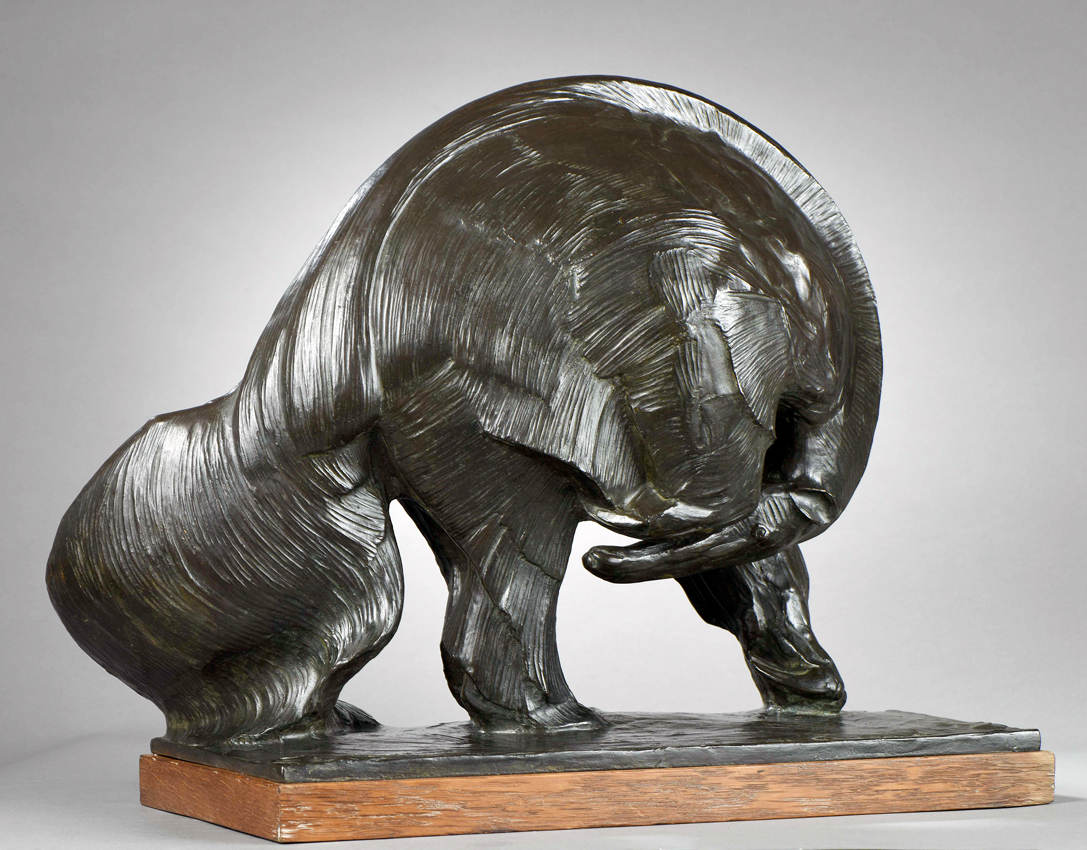
December 18, 2016
This Rembrandt Bugatti bronze of ‘The Giant Anteater’ (Le Grand Fourmilier) more than lived up to its status as the potential star at a recent auction in Paris.
The sculpture went under the hammer in the first ‘prestige’ auction to be held by the new Paris auction team of Guillaume Crait and Thomas Müller on December 2 at the Hotel Drouot.
In a full room, it drew strong demand and easily overtook its €600,000-800,000 estimate before it was knocked down at €1.2m (£1m), the highest sum paid for the sculptor’s work at auction in France.
The 19in (47.5cm) wide patinated bronze was a lost-wax cast by the Hébrard foundry from pre-1934 and was numbered 5 on the plinth. It came from a French collection, was signed R Bugatti and stamped with the Hébrard seal.
Bugatti created this model in 1909 when he was 25 years old and had already been fascinated for some years by exotic animals which he regularly went to observe at the Jardins des Plantes menagerie in Paris and the Antwerp Zoo.
He shows the anteater bent to lick its paw, a pose that accentuates the creature’s natural circular geometry.
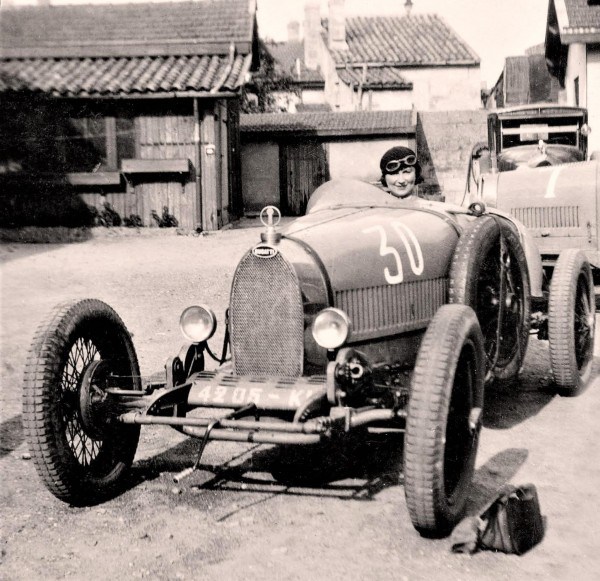
December 17, 2016
Top photo: Anne Rose Itier sitting in a 1927 Bugatti Type 37A.
The history of motorsports usually revolves around men who became heroes behind the wheel.
However, this year’s Arizona Concours d’Elegance features a panel discussion that looks into the exciting lives of women who raced professionally since the 1920s, and made their marks in a man’s world.
“Legends: Pioneer Women in Racing” is one of three panel discussions that took place Saturday, Jan. 14, on the eve of the Arizona Concours Sunday, Jan. 15.
Both the discussions and the fourth annual Arizona Concours will be at the historic Arizona Biltmore Resort in Phoenix, once again leading off the Scottsdale/Phoenix area’s famed Classic Car Week of auctions, parties and events, according to a press release.
The “Legends” panel will include veteran race driver Janet Guthrie, the first woman to compete in both the Indianapolis 500 and the Daytona 500 in the 1970s, and Miranda Seymour, an acclaimed author whose book, Bugatti Queen, explores the life of Hellé Nice, the famed French woman racing driver who competed in the 1920s and 30s.
Another female racing star, Lyn St. James, also of Indianapolis 500 fame, will moderate the discussion, the release states.
Along with the discussion will be several pre-war Bugattis raced by famous woman drivers:
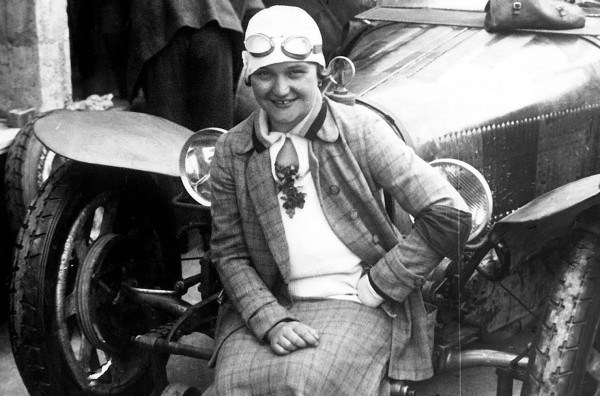
According to a release, another Saturday panel discussion, “Driven: The Passion Driving Race Team Owners,” will include renowned motorsports team owners Chip Ganassi and Bobby Rahal.
Ganassi, is one of the 50 most-influential people in the auto industry according to Complex magazine, is a motorsports legend who currently has teams racing in NASCAR, IndyCar, IMSA, FIA and Red Bull Global RallyCross.
Rahal was a three-time CART Indy racing champion and an Indianapolis 500 winner when he joined up with late-night host David Letterman, and now Mike Lanigan, as a team owner in 2002. Rahal Letterman Racing won the 2004 Indianapolis 500 with driver Buddy Rice.
The Saturday panels start at 9 a.m. with the annual Phoenix Automotive Press Association (PAPA) preview of the seven collector car auctions that take place later in the week. The discussion features well-known collector car industry writers and commentators.
For more information and to purchase tickets, visit www.ArizonaConcours.com.
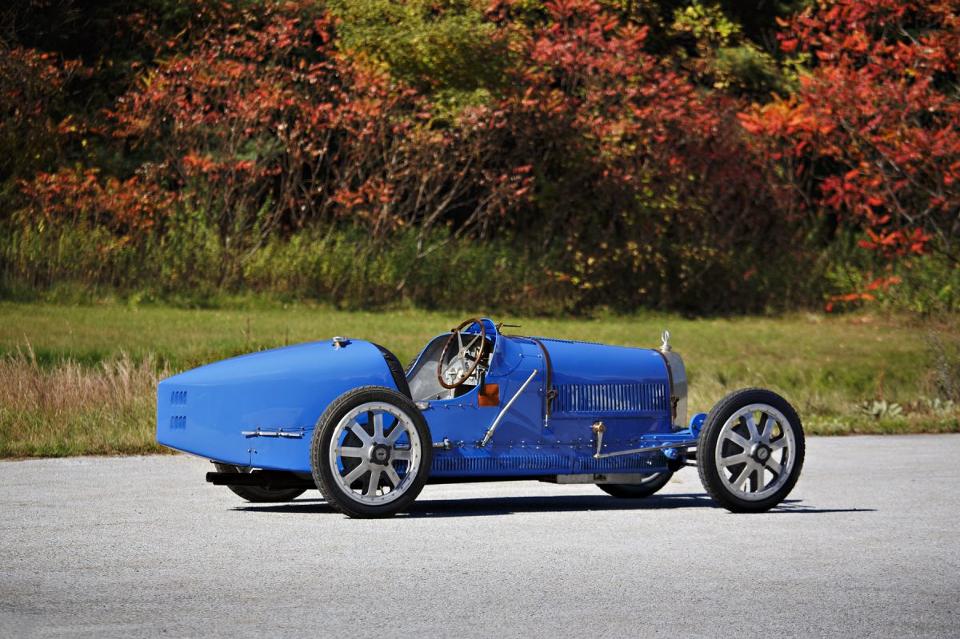
December 4, 2016
Scottsdale is coming up in January 20 / 21. Gooding has three exemplary pre-war sporting vehicles that represent good value. Any of these cars would be welcomed in vintage rallies around the world. First, a 1925 Bugatti Type 35 Grand Prix with an estimate of $2,600,000-$3,200,000. Chassis 4487 was sold new in Paris to American Standard Oil heir, Wallis C. Bird. Bird garaged the car at his famed “Farnsworth” mansion in Long Island, New York. He raced the Type 35 on several occasions in ARCA events on the East Coast (Mr. Bird’s ARCA racing plaque is still affixed to the dash) before passing away in 1941 in an aviation accident. The Bugatti sat among his stable of exotic automobiles until 1961, when his wife, Marjorie Winifred Bird, passed away.
Following her death, the Bird estate held the "Car Auction of the Century" where 4487 was purchased by pioneering collector Henry Austin Clark. The current owner purchased the car from Clark over 35 years ago and 4487 has been in his loving care ever since. With just three owners from new and in exemplary condition, 4487 represents the purest expression of the original Type 35 Grand Prix. Finished in French Racing Blue, it is a sensational example retaining its original chassis, bodywork, engine, and distinctive early-production features.
Three-owner 1925 Bugatti Type 35 Grand Prix comes to Gooding & Co.’s Scottsdale auction. Type 35 is the definitive Bugatti, an ultra-lightweight design that racked up approximately 2000 victories in competitions great and small in a range of categories, from sports car and Grand Prix racing to hillclimbs. Estimate: $2,600,000-$3,200,00. (Photos by Brian Henniker. All images copyright and courtesy of Gooding & Company.)
Also at the auction:
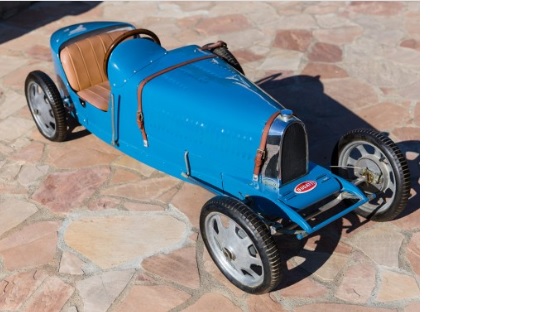
1928 Bugatti (Type 52) Bebe
Chassis: 245A
Estimate: $65,000 - $75,000 | Without Reserve
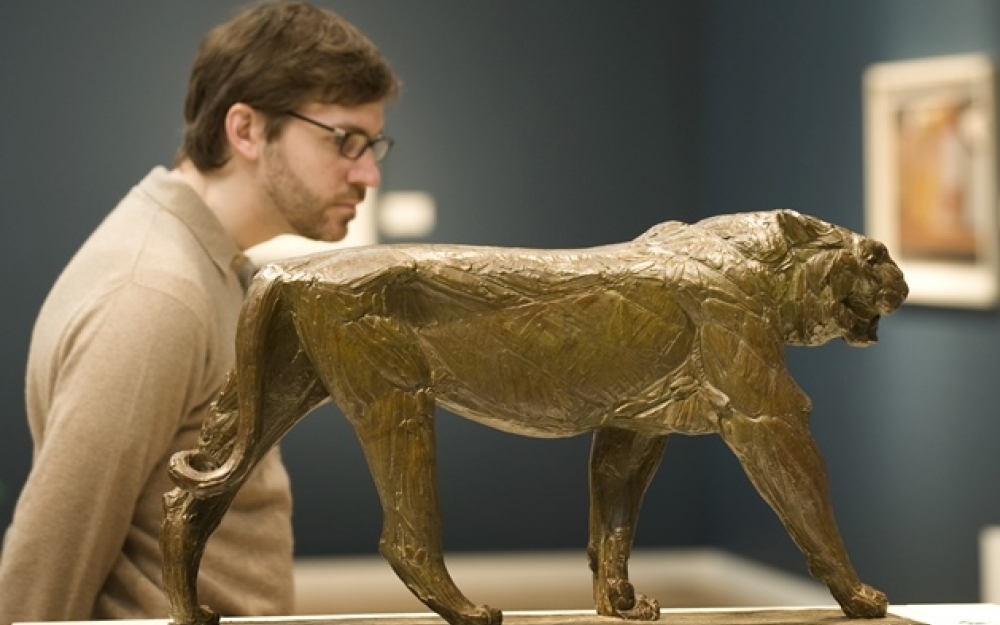
December 4, 2016
Thirteen bronze statues of Italian sculptor Rembrandt Bugatti Tuesday evening in Paris went under the hammer for 5.22 million euros. Reported by auction house Christie's. Most of the statues belonged to the French actor Alain Delon.
The thirteen works were part of a batch of seventeen sculptures. The sculpture of a panther playing with a ball is with 962.500 euros the most expensive, and the sculptures "Two panthers" and "Young Girl" went under the hammer for respectively 902 500 and 872 500 euro.
Actor and businessman Alain Delon, who is a big fan of the art of Bugatti, in recent years has put up a lot of his collection for auction. Besides the works of Bugatti he auctioned off a large part of his paintings, the content of his winecellar, his watches, his arms collection and his Ferrari.
December 4, 2016
Before he encountered wet weather at the Brazilian GP, Fernando Alonso, the two-time Formula One champion, turned back time and stepped inside a 1930s Bugatti for a promotional event in Argentina.
Of course, he wasn't going to race on his own. Beside him stood Argentinian polo star Facundo Pieres, with the Bugatti going up against a speedy pony.
The race took place on a straight stretch of the Owners Club outside Buenos Aires, while Alonso admitted that the promotional event was one of the more enjoyable he had experienced.
Alonso, who last won an F1 title a decade ago after back-to-back wins in 2005 and 2006 with Renault, just shaded the race after Pieres took an early lead.
But the event clearly paid dividends for Pieres.
The Argentinian, who has had to live in the shadows of rival Adolfo Cambiaso in the last three years during the Argentine season, came out on top when Ellerstina finally ended the run of La Dolfina at the Hurlingham Open.
Editor: Ettore would have liked such a race! Except for the fact that the Bugatti is probably a Pur Sang...
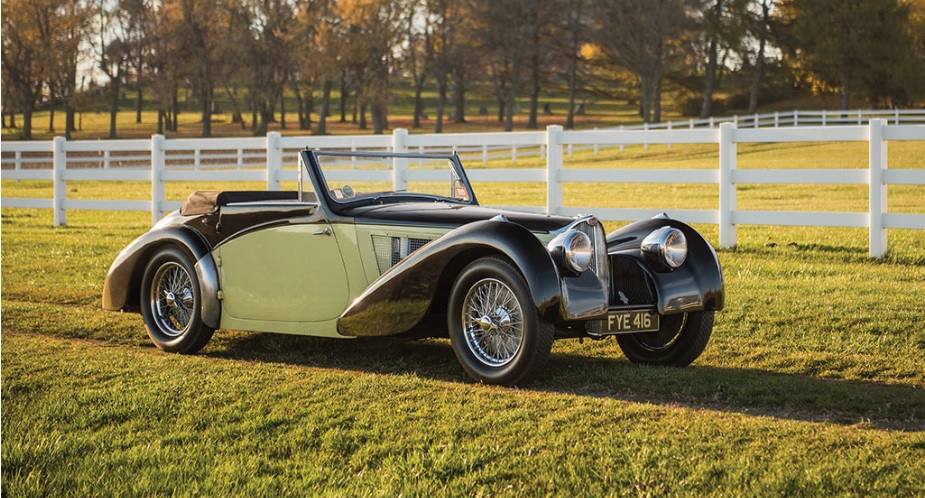
December 3, 2016
RM Sotheby's will auction this 1937 Bugatti Type 57S Cabriolet by Vanvooren in their Amelia Island sale on March 11, 1927
Chassis no. 57513
Engine no. 21S
RM Sotheby's has started lining up its consignments for its Amelia Island auction this coming March, and the highlight will surely be the Bugatti you see here.
A rare Type 57S Cabriolet from 1937, chassis number 57513 is one of only three ever made with bodywork by Parisian coachbuilder Vanvooren. Never completely restored, this Bugatti is highly original and well-documented, and is now being offered for auction for the first time in its 80-year history.
Given its elegance, rarity, and history, RM expects the Bugatti to bring in a solid $8.5 million when the gavel drops at its 19th annual auction at the northeastern Florida venue. That's within spitting distance of the $8.7 million paid for a Type 57SC Atalante in 2013 at Gooding & Company's Pebble Beach auction in 2013, and the 57SC Sports Tourer that Bonhams sold at Amelia Island last year for $9.7 million.
The French cabrio won't be the only pre-war classic up for grabs at the event, though. Joining it will be a 1930 Stutz Model M Supercharged Coupe with bodywork by Lancefield Coachworks. Impressive and imposing, it's tipped to sell for upwards of $1 million. There'll also be a 1933 Cadillac V-16 All-Weather Phaeton, one of the few of its kind to have survived in tact, valued at $400-500k.

November 1, 2016
Veteran French actor Alain Delon said Tuesday he is putting his collection of a dozen bronzes by the Italian sculptor Rembrandt Bugatti under the hammer.
Two leopards cast in 1913 by the artist brother of Ettore Bugatti, who founded the famous luxury car maker, are expected to make 1.2 million euros ($1.3 million) at Christie's in Paris next month.
The auction house said another rare bronze of a woman could reach 600,000 euros.
Delon, 80, who was once called "the most handsome man ever", has been gradually selling off his art, car and gun collections, saying: "I have accumulated mountains of things. I prefer to leave the money to my children."
Christie's, which is organising a major Bugatti sale on November 22, said the actor "has always been passionate about the artist who killed himself aged 31 during World War I", and who was best known for his wildlife sculptures.
The elephant sculpture that sits atop the radiator of the classic Bugatti Royale was designed by the artist.

October 28, 2016
From Helge Hauk
We now are very soon before printing of the „K&K Bugatti Register“, it will have more than 900 pages, shared in 2 Volumes with a common slipcase. 500 numbered copies will be sold. The shop price will be € 200.- (+ post&package).
For all those, who will preorder and prepay the books until 10 th of November 2016 – we have to cover a part of the printing costs by payment in advance – the special price will be € 180.- + p&p!
Please confirm your preorder to me ( dr.hauk@chello.at ), you will receive via e-Mail the bank data for prepaying! Also PAYPAL to our editor is possible.
The “K&K Bugatti Register” will be delivered this year!
K&K means “Kaiserlich & Königlich”, a part of the name of the “K&K Austro-Hungarian Monarchy”. We are covering a major part of Mid-Europe, that’s Austria, Hungary, Czechoslovakia and other parts of the former Monarchy and the following nations, from the beginning to nowadays. About 300 classic Bugattis, some described with full history, others with less history, many, many never before published period photos and documents of private sources, as well as pix from unidentified cars.
p&p for Europe is €20.-, overseas shipping is € 40.-
Helge Hauk - www.bugatti-club-austria.at
See also: THE k. & k. BUGATTI REGISTER by PÁL NÉGYESI, MILAN TYMEŠ, JAN KRÁLÍK, DANIEL TOMICIC, HELGE HAUK

October 28, 2016
The Arizona Concours d’Elegance, a celebration of fine automobiles at the historic Arizona Biltmore Resort, has announced that the magnificent 1936 Bugatti Type 57SC Atlantic coupe from the Mullin Automotive Museum will be shown at the Concours on January 15, 2017.
One of the greatest automotive jewels of the Art Deco era, the Bugatti Atlantic will star in a special class of Bugatti automobiles, adding its elegant form to the Art Deco ambiance of the Arizona Biltmore, which was completed in 1929.

October 28, 2016
An international jury has named the Bugatti Chiron as the winner in the “Exterior Premium Brand - Luxury” category.
The world’s most powerful, fastest, most luxurious and most exclusive production super sports car has the best design in the world.
In its “Automotive Brand Contest”, the German Design Council honours outstanding product and communication design in the automotive industry every year.
At this year’s awards ceremony, the Bugatti Chiron was selected by the jury as the winner in the category “Exterior Premium Brand – Luxury.”
The awards ceremony was held on the occasion of the Paris Motor Show.
In the category of “Exterior Premium Brand – Luxury”, which takes a closer look at the exteriors of all vehicle classes under the aspect of elegant design, the Chiron convinced the jury.
The Automotive Brand Contest is held annually by the German Design Council.
As the only impartial design competition for automobile brands, it has rapidly established itself as one of the world’s most important competitions in the industry.
“The Bugatti design team is extremely pleased about this award,” said Achim Anscheidt, Chief Designer of Bugatti, at the awards ceremony held in Paris on Thursday evening. “The stylistic challenge posed for us designers by the tension between Bugatti’s traditional brand DNA and the need to adapt the exterior design of the car to the technical requirements of this ultimate 1,500 PS super sports car was enormous. Honours like this and the extremely positive reaction of our customers and fans to the Chiron confirm that we adopted the right approach.”

October 23, 2016
Bugatti, maker of the world's fastest and most expensive production vehicle, is experimenting with an electric powertrain that delivers 597 kW of power. That's roughly 800 horsepower!
Auto Express reports that engineers from the Volkswagen-owned company have fashioned their prototype after Audi's R8 E-Tron powertrain. The E-Tron concept has two electric motors, one at each axel, that produce a total of 313 horsepower and 3,320 lb-ft of torque. The vehicle is essentially a rocket that goes from 0 to 62 mph in 4.8 seconds.
The Bugatti prototype is based the chassis of a Bentley Continental GT, features advanced lithium-ion battery packs and delivers 1,623 lb-ft of torque at 0 mph.
While the car reportedly exists, it's unknown if the public will ever get a glimpse of it. Company insiders have suggested that the vehicle is purely a demonstration model. Engineers would study and tweak it to explore the ultimate performances available from electric cars.
One of the problems still to be solved is that, at full power, the batteries only last for minutes...
But if you're looking to ditch your Prius for something a little more James Bond-like, you may still have a shot at this car. The first electric Bugatti was built during the 1930s but it wasn't intended for production. Called the Type 56, the vehicle was used to carry founder Ettore Bugatti around the Molsheim facility in France. A few others were built for customers.
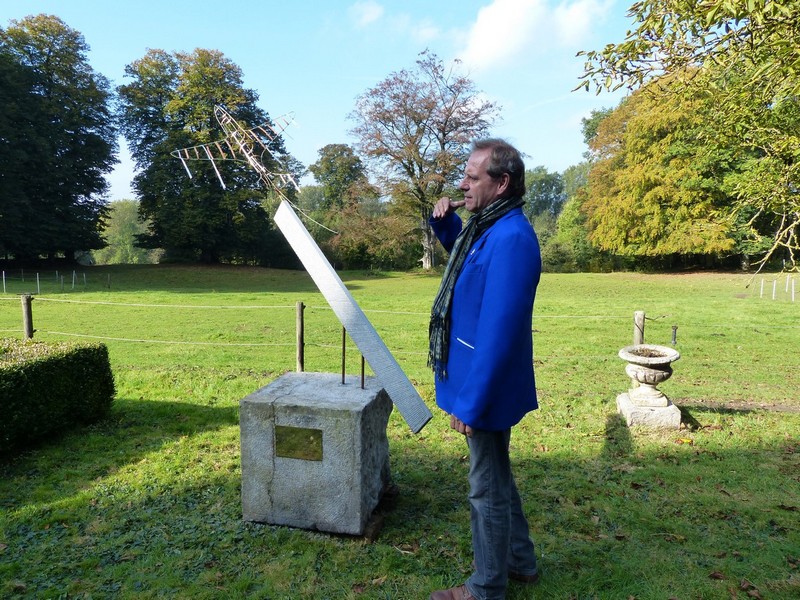
October 18, 2016
The Bugatti Aircraft Association organised a meeting at the Château the Wallay, in Ohey, Belgium, the birthplace of Louis de Monge, the aeronautics engineer who designed the Bugatti 100P raceplane. Though the meeting had been planned long before, it became a very special meeting in honour of Scotty Wilson, who had a fatal crash in his replica of the Bugatti, on August 6.
Most special was the sculpture to remember Scotty, made by Ladislas de Monge, little nephew of Louis de Monge and sculptor by profession. The BAA members shared their experiences and memories they had with Scotty Wilson
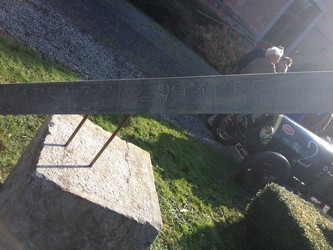
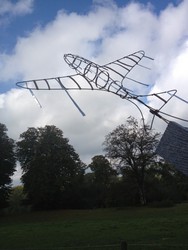
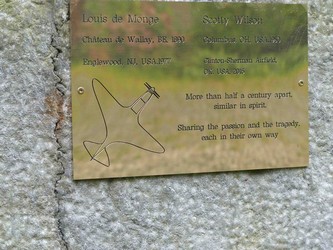
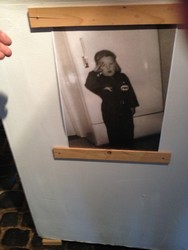
Top Photo: Ladislas de Monge explaining about the sculpture he made.
Above: The rear of the long stone has the coordinates of Burns Flat engraved, the crash site. Detail of the sculpted plane. Inside the plane there are two small metal birds. The plaque on the sculpture, which commemorates Scotty Wilson, as well as Louis de Monge. Photograph that Ladislas received; Scotty Wilson, 4 years old...
Ladislas de Monge cited (in French) the poem "High Flight" by US pilot John Gillespie Magee. Afterwards, Dick Ploeg cited the poem in English:
Up, up the long, delirious, burning blue
I’ve topped the wind-swept heights with easy grace.
Where never lark, or even eagle flew —
And, while with silent, lifting mind I've trod
The high untrespassed sanctity of space,
– Put out my hand, and touched the face of God."
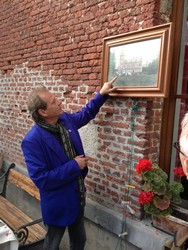
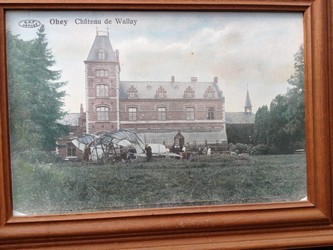
Ladislas de Monge explaining the 2nd airplane that Louis de Monge built, together with his brothers and sisters, in 1909, when he was only 19 years old. Two damaged propellers from this airplane show that, if the plane really flew, it must have been quite short. The castle is still in the hands of the de Monge family, with Ladislas' sister Véronique now living there with her husband Michel.
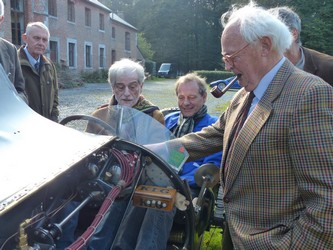
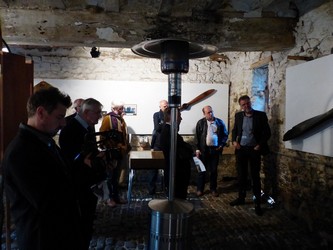
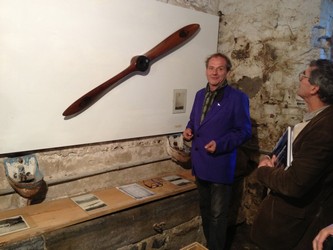
Paul-Benoît and Ladislas de Monge in the small Brescia Bugatti, two of the Brescia engines were used in the de Monge 7.5 flying wing airplane of 1921. A small exhibition with various original items from the time that Louis de Monge was successfully building airplanes.
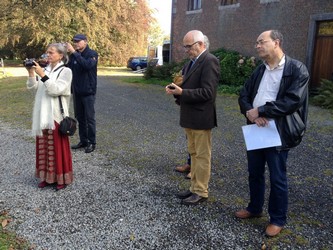
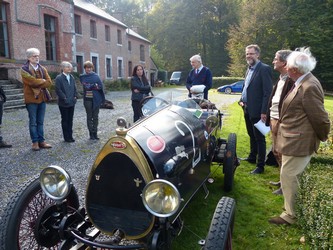
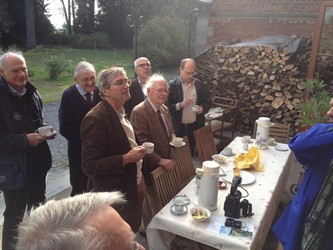
The audience during the remembrance, and at several other times during the meeting. Kjeld Jessen took his Bugatti Brescia with him, for all members to admire, and enjoy! There were 10 BAA members present, plus many members of the de Monge family.
The meeting was a good memory to honour Scotty Wilson in the first place, but also to share experiences and knowledge. BAA president Jaap Horst held a speech about the post war activities of Louis de Monge, when he was in the USA. Info that the family did not yet know. Finally there was a positive conclusion to the day, when Jaap told the family that their great uncle had been working on the aerodynamics of the Bugatti that won the le Mans 24 hours in 1939. Aerodynamic feautures that were very advanced, much more advanced than on the le Mans winner of two years earlier, and in fact no racecars with such advanced aerodynamics were built until the 1970's...
Thanks to the de Monge family, and especially to Véronique, Ariane and Ladislas.

September 25, 2016
I have had some slight problems with my computer, which means that I can not use it, and it also seems that all files are unaccessible. Hard disk seems to be completely broken...
This als means that I lost all my E-mails, so if you sent me an e-mail this last month or so, please send again!
Excuses for that..
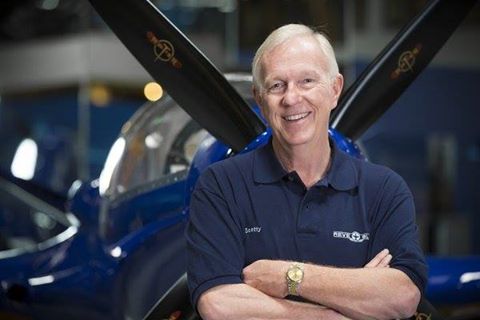
September 1, 2016
A Memorial Service with Military Honors will be held for Lt Col Scott E. Wilson, USAF (Ret), who tragically passed away on August 6, 2016.
In lieu of flowers, donations can be made to the Scotty Wilson Bugatti 100P Legacy Fund administered by Le Reve Blue LLC, dedicated to Scotty’s memory and the preservation of the Bugatti 100P Project, by clicking on the donate button on the Bugatti100P.aero website, or to the Gary Sinise Foundation at www.garysinisefoundation.org.

August 27, 2016
Gooding & Co Pebble Beach Auction, August 20/21:
1932 Bugatti Type 55 Roadster, Chassis: 55213
Engine: 10, Driven by Achille Varzi in the 1932 Mille Miglia. Estimate $10m - $14m, Sold: $10.4m

Bonhams Quail Lodge Auction, August 19:
1931 Bugatti Type 51 Grand Prix Two-Seat Racer Chassis no. 51121, Ex-Earl Howe, Hon. Brian Lewis, Piero Taruffi, Tazio Nuvolari, Arthur Dobson, and Bill Serri Jr. sold:
US$ 4,000,000,
€3,542,958
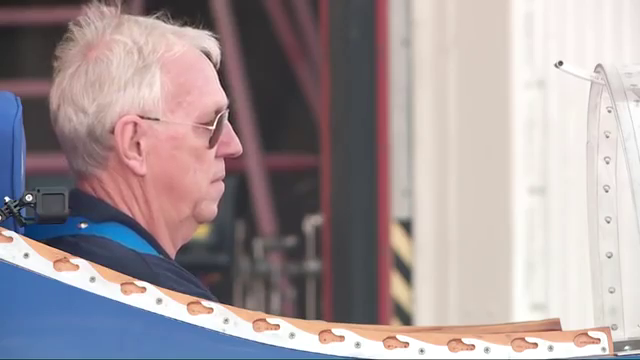
August 14, 2016
Dear readers.
It will be possible for all of you (who have not yet done so), to express their condolences by leaving your name at the Bugatti 100P replica team website at:
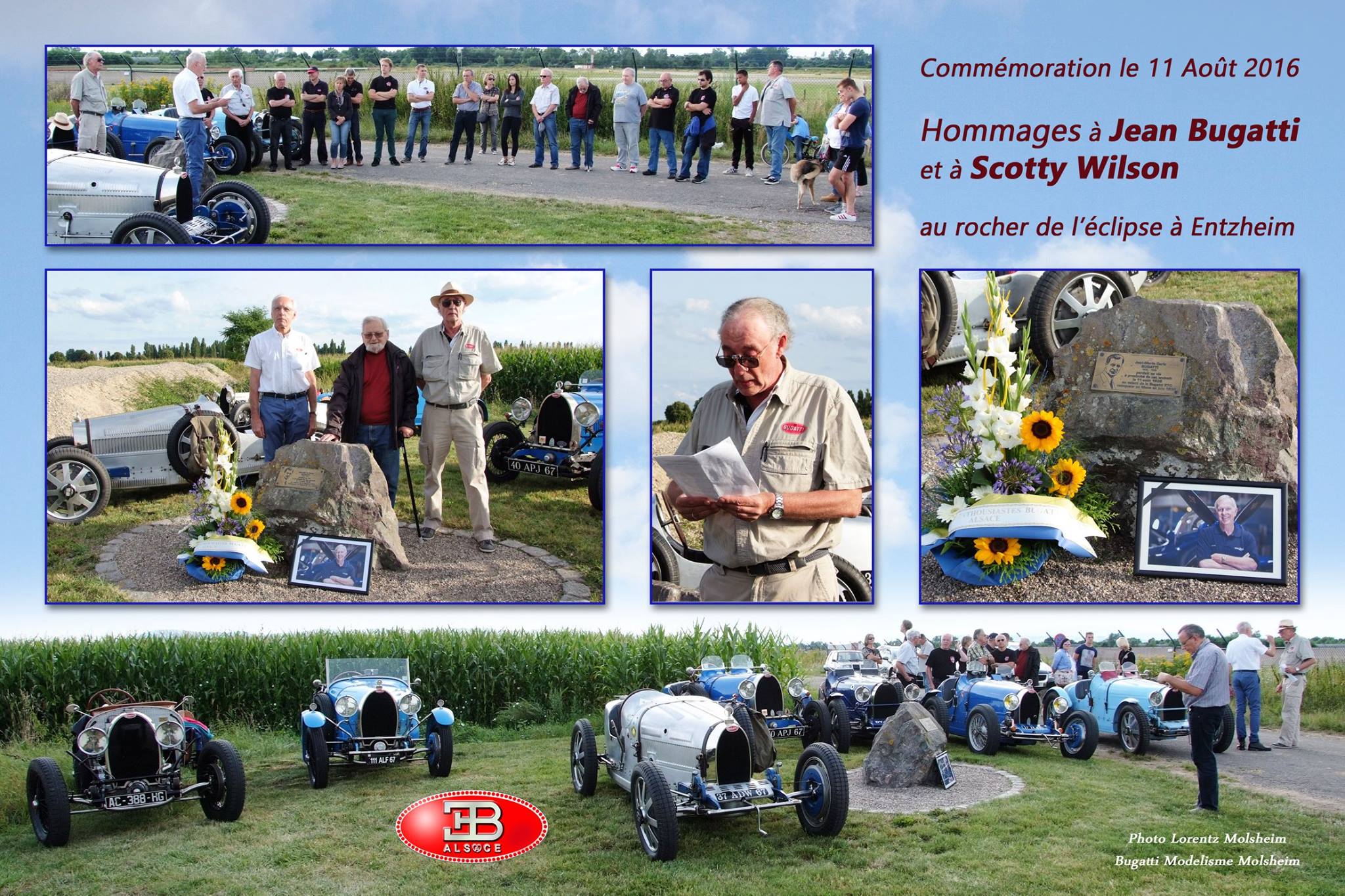


August 11, 2016
A video made by KFOR circulates on the Internet of the start of the last flight of Scotty in his magnificent airplane. I wasn't going to post it here, as I thought some of the images are too shocking. Therefore I made a revised version, which I post here. Click on the links below
Newsitem with comments, pre-flight preparations and more.

 Carlo Bugatti in car design, I do understand that Carlo's designs influenced Ettore, but Carlo designing parts for cars?
Carlo Bugatti in car design, I do understand that Carlo's designs influenced Ettore, but Carlo designing parts for cars?
This is a Claxon, by Carlo Bugatti, 1902. Obviously the rubber ball is missing.
Made of Bronze and marbles.
One angry frog! I wonder what it sounds like!
Photographed this past weekend at the best car-museum in the world: The Louwman museum in The Hague.

July 31, 2016
Artcurial auction on July 9th, 2016: Bugatti T57 Ventoux in original condition, chassis 57547, engine 384: estimate was €250.000,- to €350.000,- , the car fetched €524.480,-.



Thanks to Ralf Scholz!

July 31, 2016
Something that does not pop-up all the time, and looks quite good actually. My friend Erik Hakstege spotted it, and at 30,000 euro not even expensive....
However, probably not directly adaptable to a chassis.
Anyway, if you want to have a look, it is on the Dutch online market site Marktplaats . Good luck!

July 16, 2016
Direct automobile links of econic marques forever gone? Messier-Bugatti-Dowty & Hispano-Suiza become Safran.
The French aerospace giant Safran recently published a press-release explaining that Hispano-Suiza is now renamed Safran Transmission Systems and Messier-Bugatti-Dowty now is Safran Landing Systems. Possibly not everybody realises, but the names Bugatti and Hispano-Suiza were still alive as suppliers of specialists aviation components. The direct links with the iconic names of Bugatti and Hispano-Suiza have now disappeared.
Of course the Bugatti name is still very much alive today, as part of Volkswagen group, but the modern supercar has no bloodline with the original company. After the death of Ettore Bugatti in 1947 the company went in decline and the original car manufacturing business of Bugatti ceased in 1952, but the production of aircraft components continued. In 1963, the Bugatti company was sold to Hispano-Suiza, which on its turn was bought by Snecma in 1968, who also acquired Messier and so the Messier-Bugatti branch was formed in 1977.
Since WWI I, Hispano-Suiza had, next to its exotic car production, a long history of aircraft engine manufacture, and when after WW II the French branch's car division was stopped, it went on to build aircraft landing gear and Rolls-Royce jet engines under licence. It was then integrated in the Snecma group who later merged with Sagem into Safran. The original Spanish company had faded already long before...
It is sad news indeed when these old names are erased by our brave new world. However, the cars live on! The names will not be forgotten by those who care and who are passionate about important cars and their history.
Words and pictures: Nick Jonckheere , Source: PreWarCar.com

July 16, 2016
Edmund Burgess, 59, was left upside down in the 1932 Type 51.
He lost control and clipped the side of a corner at the Chateau Impney Hill Climb in Droitwich, Worcs, on Saturday July 9.
Mike Dodman, 71, of Bromsgrove, who was watching the event and took the pictures, said: “He was coming around the bend when the car wobbled and a wheel clipped the corner.


“Marshals quickly lifted the car off him and he scrambled out.” Mr Burgess, one of 200 drivers taking part, walked to an ambulance which took him to hospital. His condition was later described as stable.

A spokesperson for the Chateau Impney Hill Climb said: "Edmund Burgess was involved in a racing incident during the first Saturday practice session at this year's Chateau Impney Hill Climb.
"Course marshals and rescue crews were on the scene quickly, removing him from his overturned car.
"Despite being able to walk to the ambulance, he was taken to a local hospital as a precaution for further examination. "This highlighted a number of injuries that resulted in him being admitted to intensive care. "Edmund was released from intensive care this morning and his condition has been described as stable.
“The organisers of The Chateau Impney Hill Climb would like to take this opportunity to send its best wishes to Edmund and his family."
The course measures 1,000 yards and is described as one of the nation’s most challenging hill climb courses. The weekend saw 238 competitors and around 15,000 spectators descend on the course for the event.
Remember Robert Wallace from Australia? On November 8, 2010, I published the following warning on my website:
In February 2010 a Bugattist - Robert James Wallace , age 51 from Australia , placed a series of offers to sell Bugatti parts through my BugattiPage site. Wallace entered into contracts with my readers, noted Bugattists from around the world, and also with me.
Wallace collected money, signed agreements and failed to deliver. The delivery was delayed and since March 2010 the group with money out have chased Wallace to get our money back, or the parts. Some of our Bugatti friends made the decisions to give him a chance to ''make-good'', while others sought assistance from Police. We have contacted the Police in Manila, France, Switzerland and in Australia . In the instance I was personally involved in no parts were received and no money refunded - just a tangled tail of excuses. The persons who filed criminal complaints received the first refunds. In the past month another party has received parts , but they were not all as described.
For me, I demanded the parts I purchased or a refund. I gave Wallace the benefit of the doubt for too long in hindsight. To date there has been no action to my repeated demands to Robert Wallace.
During the chase it was discovered that the parts I purchased had been sold twice, though I am informed that of these parts (T51 and T35 wheels) multiple sets were in Wallace's possession. The situation is under investigation as fraud now. None of the parts I signed to purchase have been delivered and the money I sent - over 12.000 Euro - has been reduced to a promise of a refund with a load of personal excuses that are questionable and ever changing.
Today I made this decision to WARN other members of the Bugatti community. If anyone else has purchased parts from Wallace and has a problem contact me directly. I will refer you to the legal authorities that will take the details for their investigation. I will keep this warning up until Wallace corrects all of his mis-deeds with our community of Bugattists. Regardless of excuses, the acts of Wallace performed has caused all involved a great deal of wasted time and a large amount of money.
Fast forward to the present day; and Mr Wallace in Australia.
One of the Bugattistes who was conned, won a court case against Mr. Wallace, but in his usual style he completely ignored his contacts and refused to accept mail from him.
Later that year his house was sold by his second mortgagee for $A1.3 million but Wallace owed so much they did not get all their money back.
He went to ground and the Bugattiste eventually located him with the help of the Aussie police. After warning Wallace that he would take bankruptcy proceedings against him if W. failed to pay up, the Bugattiste finally set the proceedings going a short while ago.
It seems to be no surprise to find that someone else had already had him declared bankrupt at the end of 2013.
The Bugattiste followed this up and found the following:
Even after selling his house, Wallace still owed $A210,000 and had assets of $A295 so he is completely broke and living in some hole on the outskirts of Sydney.
While the Bugattiste is annoyed that there is no chance of getting his money back he is pleased that Wallace has hit rock bottom. As he is nearly 60 he has little chance of ever sorting his finances again, so he can live with the results of his actions for the rest of his life.
And the Bugattiste: he eventually got the parts he needed, even though he had to pay for them twice, and they are now gracing his Bugatti rolling chassis.
UPDATE!
I get a message from Peter Cowen in Australia that Wallace continues to con people, this time with Mustangs (the four wheeled kind, not the four legged), see: www.mustang.org.au/forum

July 2, 2016
Bugatti’s modern era doesn’t begin with Volkswagen, but with Romano Artioli, an Italian entrepreneur who acquired the Bugatti brand in 1987, and established Bugatti Automobili S.p.A.
Artioli commissioned architect Giampaolo Benedini to design the factory which was built in Campogalliano, Modena, Italy, and by 1989 plans for the revival of the brand were presented by Paolo Stanzani and Marcello Gandini – both with a big resume in the Italian motoring industry, which included icons like the Countach and Miura.
Shortly after, the Bugatti EB110 entered production in 1991, exactly 110 years after Ettore Bugatti's birth. The car wasn’t a huge financial hit, considered by many to be an underdog till this day, but it featured a carbon-fiber reinforced polymer chassis and a 60-valve, quad-turbo V12 fed through 12 individual throttle bodies, powering all four wheels via a six-speed gearbox. The engine was capable of 560 PS (552 HP) at 8000 rpm, catapulting the car from 0 to 100 km/h (62 mph) in 3.2 seconds, topping out at 213 mph (343 km/h).
The SS variant was even more powerful (as well as lighter), boasting 612 PS (603 HP), a 3.2-second 0 to 100 km/h (62 mph) time and a top speed of 216 mph (348 km/h).
Things were looking good for Bugatti, as its owner then purchased Lotus Cars from General Motors in 1993. Unfortunately, the company’s success was short lived, going bust in September 1995 due to bad economic conditions and poor sales, although Artioli says the reason why Bugatti ceased to exist was caused by other factors.
In a recent documentary, Artoli explains how the company was sabotaged by the competition, without giving a specific name. According to the former owner, the “specialists” – as he described them – went directly to the parts suppliers and intimidated them to stop providing their services to Bugatti:
"If you supply another spare part to Bugatti, you won’t work with us again. You choose. One part a day against a thousand you make for us. You’ll figure it out."
"At the time it was a gang. The Mafia was a troop of boy scouts in comparison”, said Romano Artioli.
The rabbit hole goes much deeper than that, but will let you watch the Kidston documentary to get a better understanding.
THE FORGOTTEN SUPERCAR from Kidston.TV on Vimeo.

June 26, 2016
On the 19th of June there was a serious accident, as reported by the newsitem in the Swiss newssite 20minutes, photograph by Chris Gardner:
Two American women aged 65 and 23, were seriously injured in an accident that occurred Sunday around 17 hours.
The two women were taken to the University Hospital of Lausanne, one by helicopter and the other by ambulance, announced the Vaud police in the evening.
A car in Vaud plates occupied by two Swiss women of 21 years came off highway A1 at the junction of Cossonay. Arriving at the roundabout, it joined in the middle of a series of vintage Bugattis circulating Cossonay towards Sullens.
Thinking to pass between two vehicles, the car entered the roundabout. Almost simultaneously, the car was hit from behind by the Bugatti registered in Britain that drove normally.
The Bugatti Brescia was thrown into the air. Both occupants were ejected and fell back heavily on the pavement. Their lives are not in danger. The occupants of the vehicle causing the accident were not injured.
Corrections: by Karel Van de Velde, member of the Organising-Committee of the Internationale Bugatti Meeting 2016 in Montreux, Switzerland.
1. The accident did not take place during the Internationale Bugatti Meeting, but the day before that, Sunday June 19, 2016.
2. The Bugattis did not travel in convoy. There were however some Bugattis underway from L’Isle to Cheseaux-sur-Lausanne.
2 Bugattis were following eachother, the first had already passed the roundabout for about 50 m, when the 2nd Bugatti was cut-off by a modern vehicle that entered the roundabout without stopping or giving precedence to the Bugatti on the roundabout.
The Finest Automobile Auctions, The elegance at Hershey, June 11, 2016:
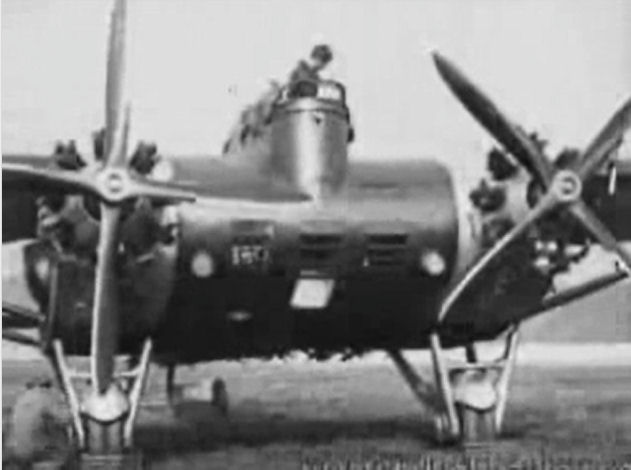
June 2, 2016
You might think, what on earth does this newsitem have to do with Bugatti?
Well, you of course know the Belgian Louis de Monge, who was the designer of the Bugatti 100P airplane. Louis de Monge, 15 or more years before starting for Bugatti, did many different flying wing designs. He actually did some design work for the company Dyle & Bacalan of Bordeaux, France, and probably had some influence on this design.
However, it is just a lot of fun, watching this bomber airplane take off!
Click here or on the image above to go see the movie on the BugattiAircraft.com website

May 27, 2016
The British magazine Classic & Sportscar, is organizing a best supercar of the past century election, this is the feature for the 2016 Classic & Sports Car Show will be A Century of Supercars.




For each of eleven decades, from before 2014 to the 2010's, there are 3 cars to chose from. Thus a total of 33 cars, and amongst those 4 Bugattis, in the era 1914 - 1929 the Bugatti Type 43, in the 1930's the Type 57SC, in the 1990's the Bugatti EB110, and in the 2000's the Bugatti Veyron.
Help Classic & Sports Car identify the greatest supercar of all time. And while you do it play a part in creating an amazing display at the capital’s leading classic car show and put yourself in with a chance of winning a VIP trip to Alexandra Palace in October.
After weeks of argument, debate, compromise and picking straws our expert jury has selected its most significant supercars from every decade or era to satisfy a range of criteria. While some of your favourites may be missing (no Daytona, no Enzo, none of the more recent strictly straight-line heroes – heresy!), we are happy that for performance, historical importance or otherwise this is the cream of the crop.
Just choose your favourite from each group and log your details to be automatically entered into a draw to win two Gold tickets worth £100 a pair to The Classic & Sports Car Show at Alexandra Palace from 28-30 October.
At the end of August we will launch another poll pitting all the group winners against each other to determine the greatest supercar ever. The overall winner will be revealed at The Classic & Sports Car Show where the fabulous central display will be made up of all the contenders.
Read More, and vote from June 1 onward!
Auction - The Monaco Sale 'Les Grandes Marques à Monaco' Monte Carlo, May 14, 2016:
1925 Bugatti Type 35 Grand Prix Two-Seater Chassis no. 4450, Estimates: €1 million - 1.5 million / £770,000 - 1.2 million /
US$ 1.1 million - 1.7 million, Sold for €1,058,000 - £834,656
The new owner is none other than Simon Kidston, finally the car returned to the family after a few decades.
RM Sotheby's Auction - The Quattroruote Collection, Le Sporting Monte-Carlo, Monaco, May 14, 2016:
1939 Bugatti Type 57 Cabriolet by Gangloff, Chassis no. 57731, Engine no. 527, Estimate: €500.000 - €600.000, Sold for €660.800
RM Sotheby's Auction, The Agusta Collection, Monaco, May 14, 2016:
1928 Bugatti Type 40 Roadster Chassis no. 40532, Estimate: €150.000 - €200.000 / $165.000 - $225.000, Sold for €168.000
Thanks to Christophe Chanterault!

May 20, 2016
Molsheim/Vienna, May 20, 2016.
At this year’s International Business Film Festival (Internationale Wirtschaftsfilmtage) in Vienna, Bugatti received the Silver Victoria for its film “Bugatti Chiron – Breaking New Dimensions”. A jury of 21 specialists from the worlds of film, media and industry selected the best corporate films from several hundreds of entries submitted from the German-speaking countries. The contribution of the French super sports car maker stood out as one of the best among the 25 entries in the category of trade fair, event and visitors’ films.
Bugatti produced the film for the world premiere of the world’s most powerful, fastest, most exclusive and most luxurious production super sports car at this year’s Geneva International Motor Show. The video film, which is about two minutes long, consists of two parts. The first part presents the origins of the traditional luxury brand in a poetic and artistic way. It outlines, in complex, aesthetically pleasing images, the history of Bugatti from its early classics, the Royale, the Type 35 and the Atlantic, through to the Veyron, the modern super sports car that has established its place in the history of the automobile over the past 10 years. At the start of the second part, the mood and imagery change in order to present the new ultimate super sports car, the Chiron, with the many facets that make it unique: extreme performance, speed, agility, luxury and elegance.
Bugatti implemented the film in cooperation with DNS multimedia factory GmbH of Hamburg. With its power output of 1,500 PS, unprecedented in a production vehicle, torque of 1,600 Nm and a wide variety of technical innovations, the Chiron sets new standards in every respect.
The International Business Film Festival is the main festival for corporate films in the German-speaking region. The festival has been held every two years since 1963 to honour the best image films, contributions in the fields of internal communications, marketing, tourism and trade fairs, and TV productions with a business theme. Numerous visitors came to Vienna for the award ceremony on Thursday evening.
The award-winning Bugatti film is available by clicking on image above or on: www.youtube.com
Comment: Impressive way to visualise, though the painting of the Atlantic is one of the worst I ever saw.

May 16, 2016
I must apologize, as I did advertise this "High class magazine" myself, on this website.
Futhermore, I should have alerted sooner, maybe. The fraud was not really an obvious one though, as there really is a fantasymotors.com website, Spencer Benterud, the guy who owns both the Fantasy Motors website as well as the magazine seemed quite knowledgeable about Bugattis and the world of high-cass motoring. On the website, samples of the magazine were shown which showed that quite a bit of work had been done.
However, the next things show it's a fraud:
What to do:

May 10, 2016
Designed in 1902 by Carlo Bugatti – the furniture-designing father of Ettore – the Cobra chair soon became an all-time great. It’s now been reinterpreted for the 21st Century as part of Bugatti’s new Home Collection…

Created by Italian architect Carlo Colombo under the guidance of Bugatti’s interior designer Etienne Salome, the new Cobra chair re-interprets the stylistic influences of the original seat-come-sculpture, with modern materials and brand cues that became established in later years. The 1902 Cobra became famous for its organic single-element design that incorporated a gap to allow coat-tails to hang freely; the 2016 model retains this signature cue, but adds the centreline actuation that became a hallmark of the Bugatti automobiles produced since, along with swathes of Cognac leather and a carbonfibre body structure painted in Blue Royale. It appears that the ergonomic comfort has been addressed in the 114 years between them, too.

Molsheim/Milan, 12 April 2016.
At this year’s Salone Internazionale del Mobile in Milan (Italy), Bugatti, the manufacturer of the world’s ultimate super sports car, the Chiron, and one of the world’s leading high-end furniture makers, Luxury Living Group, are launching the new Bugatti Home Collection, an exclusive range of luxury home and executive furniture. Under license granted by Bugatti, Luxury Living Group is presenting this new lifestyle project, which celebrates the lifestyle of the French luxury brand drawing inspiration from the brand’s legacy and from the unique vision of company founder Ettore Bugatti.
Bugatti Home Collection describes the elegant and extraordinary lifestyle originated from the artistically inspired environment of the Bugatti family since the beginning of the 20th century. Carlo Bugatti, the father of Bugatti company founder Ettore, designed furniture pieces himself, some of which are exhibited in museums around the world today. Under the guidance of Bugatti Design and in collaboration with Etienne Salome, head of Bugatti Interior Design, Italian architect Carlo Colombo studied and carefully reinterpreted the brand DNA to create some unique pieces of furniture, which will be manufactured and distributed by Luxury Living Group.
“Our distinctive character is increasingly moving towards a Bugatti global lifestyle”, says Massimiliano Ferrari, Head of Bugatti Brand Lifestyle for Bugatti Automobiles. “By complementing our current lifestyle collection with an interior design proposal, we are now taking another step ahead.” “Bugatti Home collection is a tribute to the flamboyant spirit which characterises the most famous automotive brand in the world”, affirms Alberto Vignatelli, CEO and Chairman of Luxury Living Group. “This furniture represents the unique style and the heart of Bugatti dominated by its key values Art, Forme, Technique”.
The characteristic style features of the French luxury brand- such as the unique Bugatti – twotone colour scheme, the Bugatti line, or the famous Bugatti horseshoe-shaped front grille - enhance the shapes of the furniture with soft and continuous lines reminding the aerodynamic design and the super cars performances. The frames in carbon fibre, the same used to produce the Bugatti hulls, draw the attention on the cutting edge technology side of the collection and its extremely complex design. Carbon fibre is a pure and extreme element shaped with perfect craftsmanship which is combined with other materials of the collection: steel, glass and leather, all carefully selected and cut to create bases, surfaces and upholsteries. The palette was developed using the historical colours of Bugatti which are mixed and combined in an elegant use of shades. Blue Royale, nuances of light blue and neutral tones such as silver grey, cashmere warm grey and the classic cognac colour.
THE COLLECTION
COBRA CHAIR Iconic piece of the collection, the famous Cobra Chair, re-interprets in a contemporary way the early version designed and accomplished by Carlo Bugatti in 1902. This cutting edge and innovative chair combines back, frame and seat in a single element with curved and continuous lines, interrupted only by a gap conceived to contain the tails of a tailcoat referring to the purpose of Carlo Bugatti’s original version. Upholstered in cognac leather, the wooden frame has been replaced by a performing solution in carbon fibre painted in Blue Royale colour on the rear part. It is enriched by a blue leather piping and by the characteristic EB monogram.
ROYALE SOFA AND ARMCHAIR The most aesthetically impressive Royale sofa and armchair re-interpret the tradition with breaking new dimensions both in terms of volumes and proportions calling for high levels of comfort and relax. The seat upholstered in soft leather is embraced by the arm and the back, which are combined in a single element made of carbon fibre which widens outwards.
ROYALE LOUNGE TABLE The Royale lounge table accurately interprets the Bugatti characteristic style features: a piece of furniture suitable for the elegant mood of high-end houses. The wide oval shape is developed from an extremely light aluminium frame, laser cut and carved with geometrical patterns taken over by the Bugatti interiors. The table top is in smoked tempered glass back lacquered in the iconic blue of the collection. The table is also available as coffee table.
ATLANTIC TABLE Atlantic is the sculptural table of the Bugatti Home collection. Its design combines volumes and curved lines resulting in an extremely elegant piece of furniture. The cone shape base is moulded in carbon fibre and supports the large top characterised by a sophisticated metal profile. The surface is covered in precious leather and enriched by the printed contour of the legendary 1936 Bugatti Atlantic obtained with a unique UV print technique.
ATLANTIC CHAIR The Atlantic chair is the result of an extremely linear project. The thin and technological frame in carbon fibre deletes the volumes and creates a piece which goes beyond the minimalistic style approaching an innovation exclusively based on material and shape. A pure and slender design, enriched by a cognac leather upholstery, which re-interprets the idea of chair with a new elegance.
ETTORE DESK WITH BOARD AND CHAIR The Ettore office desk conveys a sense of lightness and modernity: a straight top comes out of the board, extending and then lowering down to the base without interruptions. A re-design of the classic executive office desk through the performing use of carbon fibre, the top is upholstered in leather coordinated with the surfaces of the storage cabinet. The matching office chairs feature a leather seat incorporated into the carbon fibre frame.
LYDIA BED The Bugatti style characterises this masterful interpretation of the bedroom area. The bed, named after Ettore Bugatti’s daughter Lydia, translates the aesthetic codes and values of the living furniture into a contemporary solution. The wide and comfortable headboard has an embracing shape enhanced by a Blue Royale profile in contrast with the fabric or leather cover. It is enriched by a precious embroidery of the EB monogram.
About Bugatti
Bugatti is the brand of a family of artists who distinguished themselves in an environment where other automotive brands were operated by entrepreneurs with a purely technical background. The company founder Ettore Bugatti, born and raised in Milan, Italy, succeeded in uniting this artistic approach with his technical innovations, thus creating the foundation of a design language that was to mould the Bugatti marque. The result has been a series of vehicles far ahead of their time, and which are today numbered amongst the most valuable classic cars in the world. The brand’s central philosophy of “Art, Forme, Technique” is a description of its mystique.
Still based where the brand was founded more than 100 years ago, in Molsheim (Alsace, France), Bugatti today is an ingenious combination of the artistic roots of its Italian founder, the distinctive understanding of the French for exclusive luxury products and brands as well as the internationally acknowledged German engineering and technological leadership.
Bugatti holds two speed world records, the Veyron 16.4 Super Sport is the fastest production car in the world with a top speed of 431.072 km/h and the Veyron 16.4 Grand Sport Vitesse is the world’s fastest production roadster with a top speed of 408.84 km/h driven with the roof down.
At the 86th International Geneva Motor Show Bugatti presented its latest creation, the Chiron, the world’s most powerful, fastest, most luxurious and most exclusive production super sports car. With a power output of 1,500 HP, unprecedented for production vehicles, an exceptionally high torque value of 1,600 Nm and a wide variety of technical innovations, the Chiron sets new standards in every respect. Only 500 of these exceptional cars are to be produced.
Bugatti is running a dedicated Lifestyle Collection, named after Ettore Bugatti. It was launched in 2013 as a major step in Bugatti’s brand extension strategy to demonstrate that Bugatti does not only stand for benchmark technology and breath-taking performance, but also for art, design and a sophisticated lifestyle.
About Luxury Living Group
Luxury Living Group is the luxury furniture and homeware company founded by Alberto Vignatelli. Expertise, exclusive materials, creativity and quality are key to the Group’s development, with its steady expansion in technology and innovation in a short space of time. The Company, strongly driven by a vision focused on the international distribution of its products, has already developed its brands gallery collections - Fendi Casa, Bentley Home and Trussardi Casa - and its signature gallery, styled by design icons, as well as its own line, Heritage Collection. The Luxury Living Group portfolio is also enriched by the new Bugatti Home Collection as well as the new Ritz Paris Home Collection and Paul Mathieu proposals.
www.luxurylivinggroup.com/en/bugatti-home

March 30, 2016
At the recent (March 17 - 20) RETRO CLASSICS in Stuttgart, Germany, a new Royale replica was presented.
Above the only good photo I could find, and I did not go myself, I'm afraid...
The replica roadster has been built over the last 6 years in the Netherlands, by Frank Slopsma and his team, who also built the Bugatti Royale "Packard" replica which was presented at the Molsheim Festival in September 2011.
As the original body was destroyed, the existing photographs, only 12 of them, were used to make a 3D-model of the car and especially the body. The car is said to be reconstructed in every detail, until the last nut and bolt.
The photograph does show very similar colours at least compared to the existing replica of the Esders Roadster. It should be interesting to see both replica's side by side! We will hopefully see this magnificent car in more events in the near future.
RM Sotheby’s Amelia Island Auction The Ritz-Carlton, Amelia Island, Florida, USA, March 12, 2016:
Thanks to Christophe Chanterault

Bugatti T59 drawing by Robert Jarraud
Famous for one of the best books on Bugatti: "Double Arbres".

"It's a miracle!" by Trepel

"Bugatti" by Michel Michaux

March 12, 2016
Bonhams, the Amelia Island Auction, USA, March 10, 2016:
Lot 139: 1937 BUGATTI TYPE 57SC SPORTS TOURER, Coachwork by Vanden Plas, Chassis no. 57541, Engine no. 29S
Result: US$ 9,735,000, €8,778,178

March 12, 2016
Before the 1,500-horsepower Chiron debuted last week, we had to wait some 12 years between all-new Bugatti models. Thankfully, we might not have to wait that long for the next one. That's because the French ultra-luxury brand is considering a four-door sedan and it appears it might be also considering an electrified vehicle.
“I can’t get the idea for a four-door limousine out of my head,” Wolfgang Duerheimer, head of Volkswagen AG, told Bloomberg at the Geneva Motor Show. “It’s one of the options we might look into again as a possible next project.”
Durheimer also mentioned, although Bugatti skipped electrification for the Chiron, “that doesn’t mean we abandon this topic forever.” And that's a smart move.
The Chiron's 16-cylinder engine isn't shared with any other VW Group vehicles, which limits the return on research and development investment for the other brands under the VW umbrella. However, an electrified Bugatti could share its technology with the Porsche Mission E Tesla-fighting sedan and the rumored Bentley EV as well.
Moreover, electrification is likely the only way to push the Bugatti brand's performance boundaries beyond the 1,500-horsepower mark. And it's not like it can sit still and offer a new model with the same power figures as the Chiron. Surely, the global glitterati wouldn't stand for it.
Really, it would behoove Bugatti to combine both the four-door limo idea and electrification into one. I mean, why not kill two birds with one insanely beautiful and expensive stone?
While Bugatti's braintrust might be mulling both a new powertrain and a new body style, there are apparently still limits to where the brand can go. When asked if Bugatti had any interest in building an SUV, Duerheimer simply said, "No."
Top of the article: the Galibier 16C prototype presented in Geneva in 2010.

March 1, 2016
Geneva International Motor Show 2016: Bugatti Chiron – world premiere for the ultimate super sports car
The Chiron is the world’s most powerful, fastest, most luxurious and most exclusive production super sports car



So is this car so really unique? It probably is. What do you think of the design? My son called it a Veyron trying to escape from a BMW.... Be it as it may, it is probably better looking than the Veyron especially the rear, and just that bit faster to get to work in time.
But is it really better than the Veyron? We'll have to see to that. As the Veyron was already quite heavy at 1800 kg, the Chiron now is roughly 2000, empty! Mr. Bugatti would think he was making a "camion"!
Comment from the editor. the rest of this article is in fact the press release, so don't expect any criticism...
Molsheim / Geneva, February 29, 2016.
Bugatti is celebrating a world premiere at the Geneva International Motor Show: the French luxury brand is unveiling the Bugatti Chiron, the most powerful, fastest, most luxurious and most exclusive production super sports car in the world. The Chiron is the latest generation of the ultimate super sports car and is a completely new development. The sports car manufacturer from Molsheim, with its long tradition, has taken the unique features of a modern Bugatti to a new level and developed a high-performance machine that has become significantly better in every respect. With a power output of 1,500 HP, unprecedented for production vehicles, an exceptionally high torque value of 1,600 Nm between 2,000 and 6,000 rpm and a wide variety of technical innovations, the Chiron sets new standards in every respect. The Chiron is therefore very well-positioned to become the next world speed record holder and reach a maximum speed significantly above the record currently held by Bugatti. The manufacturer has limited the maximum speed of the new car to 420 km/h for road use. The Chiron is to be built at the company’s headquarters in Molsheim. Only 500 of these exceptional cars are to be produced. The basic price is €2.4 million net. Currently, advance orders have been received for one third of the total production run. The first vehicle is due to be delivered to a customer this autumn.
“It is part of human nature to cross boundaries and set new records – to run 100 m faster than ever before, to fly even further into space and to enter new realms. This striving is also our driving force at Bugatti,” said Wolfgang Dürheimer, President of Bugatti Automobiles S.A.S., at the presentation of the Chiron. “The Chiron is the result of our efforts to make the best even better.”
With the Chiron, the Bugatti President said that Bugatti had left the dimensions which define the operations of all market players and had established new paradigms that had previously not existed. “Bugatti has tested the limits of physics. There is no area where we have not achieved significant improvements.“
The Bugatti Chiron is the world’s first super sports car to bring 1,500 HP onto the road with a torque of 1.600 Nm at 2,000 to 6,000 rpm with tremendous effectiveness, extremely high safety levels and unprecedented comfort. This is the result of the legendary and unique eight-litre W16 engine that has been newly developed by Bugatti. In combination with the four new, larger turbochargers that are controlled by the Bugatti two-stage turbocharging, an innovation that Bugatti is introducing, and a large number of other technical refinements and innovations, maximum performance is available constantly and can be easily controlled at all speeds. In its Top Speed mode, the car reaches the maximum speed of 420 km/h, limited for road use – however, this is by no means the end of the road for the Bugatti Chiron.
With the new carbon fibre monocoque, a newly designed adaptive chassis, tyres developed especially for Bugatti and other innovative technologies, the Chiron is not only a champion in terms of maximum acceleration but is, for the first time, also an agile, modern Bugatti with handling that ensures maximum driving pleasure.
The design of the Chiron combines significantly more “beast” with a very high level of “beauty”. The design language introduced by Bugatti with the Chiron has a significantly more aggressive tone and does justice to the character of the new super sports car. The designers have succeeded in reinterpreting Bugatti’s DNA with its distinctive features in a modern manifestation at the same time as adding new features resulting from the technical demands of even higher performance. The Chiron remains unmistakably a Bugatti.
“The Chiron is the quintessential ultimate super sports car: ultra-modern, incredibly fast, agile and powerful with a stylistically demanding design and the highest possible levels of comfort,” says Wolfgang Dürheimer. “This combination is not offered by any other market player and gives Bugatti its unique market position.”
“Our customers form an exclusive group of automobile collectors who are searching for the very best. With the Veyron, they have the best production sports car of the past 10 years,” Dürheimer continues. “This is why their demands and expectations for our next step – the Chiron – were so high.“ Customers’ reactions show that Bugatti has hit the mark. Advance orders have already been received for one third of the production series. “Those who have already considered Bugatti and its unique features in connection with the purchase of a Veyron will find there is no way they can ignore the Chiron,” according to Wolfgang Dürheimer. “With the Chiron we will not only be providing a key emotional element for the image of the Volkswagen Group but will also be making a positive contribution to Group results,” says Wolfgang Dürheimer.
The Chiron can be seen on the Bugatti stand in Hall 1 at the Geneva International Motor Show from March 1 to 13.


The Chiron in detail
Powertrain


Powertrain
Newly developed W16 engine
1,500 HP was the power target for the Chiron. To achieve this objective, the eight-litre W16 engine which is already well-known to customers and fans was completely redesigned. To achieve a power boost of 25 percent compared with the predecessor, almost every component of the engine was considered and redesigned. To compensate for the weight increase caused by the high power output, greater use is made of lightweight materials such as titanium and carbon fibre. For example, the intake tube, the charge air system and the chain housing are all made of carbon fibre. The weight of the new crankshaft has also been optimised. The key factors in the increased power output are higher-performance turbochargers and duplex fuel injection with 32 injectors. In addition, the charge air cooling system has been improved. As a result, more than 60,000 litres of air per minute are pumped through the engine. The coolant pump is also a very high-performance unit. In one minute, it circulates 800 litres of water through the entire engine.
Two-stage turbocharging is the outstanding technical feature of the powertrain
The engine is fitted with four larger, higher-performance turbochargers. They are operated in a two-stage configuration. The two-stage turbocharging system developed by Bugatti especially for this car is the outstanding technical feature of the Chiron powertrain. To ensure maximum acceleration from a standstill without the “turbo lag” feared by sports car drivers, the Chiron moves off the mark with only two turbochargers in operation. The other two units are only activated at about 3,800 rpm. As a result, the two-stage turbocharging delivers an absolutely linear power curve from 2,000 rpm, huge torque in the low engine speed range and a power output that can be controlled and dosed rather well. New titanium exhaust system / the main catalytic converters are about six times as large as the unit fitted to a medium-sized car
Another feature that boosts the power output is the new titanium exhaust system with reduced exhaust gas back pressure. The system is fully insulated and equipped with four pre-converters and two main catalytic converters which are considerably larger than their predecessors. The main converters are about six times as large as the unit fitted to a medium-sized car. The total active surface of the six converters used for exhaust gas treatment is about 230,266 m², corresponding to the area of more than 30 soccer fields. From the catalytic converters, the exhaust gas is fed to a silencer which is extremely light compared with similar units, weighing only 20 kg. While other manufacturers use stainless steel, the silencer of the Chiron is made from titanium. The exhaust system is rounded off by six tailpipes, with four routed to the rear and two pointing downwards.
The transmission has the largest, highest-performance clutch fitted to a passenger car
The powertrain features a front-axle differential with integrated inter-axle lock and a rear-axle differential with integrated inter-wheel lock and a seven-speed dual-clutch gearbox designed for a torque of 1,600 Nm. This gearbox developed especially by Bugatti has the largest, highest-performance clutch used on a passenger car. It goes almost without saying that the Chiron has permanent four-wheel drive.


Structure
Highly sophisticated monocoque with extremely high rigidity – LMP1 level
The monocoque of the Chiron is made entirely from carbon fibre and is designed for crash protection. This newly developed unit is the technically most sophisticated monocoque in its class. For the first time, the rear end of the car is also made from carbon fibre. If all the fibres used in the monocoque were laid out end to end, they would stretch nine times the distance between the earth and the moon. The production of a monocoque takes four weeks. Thanks to the use of high-performance high-tech materials, the structure of the Chiron at the rear end is 8 kg lighter than that of its predecessor. The structure is completed by a carbon fibre underbody manufactured by an innovative sandwich procedure. The sandwich construction, combined with optimised material use, results in a weight saving of 8 kg compared with conventional construction. The structure of a sports car is not only the decisive factor in its weight but also in its rigidity. The Chiron reaches a torsional rigidity of 50,000 Nm per degree and a flexural rigidity of about 0.25 mm per tonne. These are sensationally good values comparable to those of LMP1 racing cars.
The new design of the Chiron also meets all the latest worldwide safety standards. The Chiron boasts the most advanced airbag technology available, with a total of six airbags. Thanks to Bugatti’s outstanding expertise in airbag design, it proved possible to develop an airbag that shoots through a carbon fibre housing. This is the case with the dashboard on the passenger’s side and the seat housings.
The outer skin of the Chiron is made entirely from carbon fibre with perfectly aligned fibres flowing across the boundaries of neighbouring components without any optical interruption. This alignment, which is the result of skilful handcrafting and uncompromising attention to detail, makes the super sports car a real eyecatcher. Only the highest-quality carbon fibre fabric is used for visible carbon surfaces and six layers of clear coat are applied to ensure a perfect surface. Only Bugatti is so painstaking in this area. In addition, some parts of the body require extremely complex production processes, such as the rear compartment lid or the wings. These do not have any edges or gaps but only fantastic reflections, which also applies to the side. Bugatti has succeeded in developing a body part that extends from the A-pillar to the rear in a single piece – an extremely sophisticated part that is simply beautiful to look at. Last but not least, the new structure of the Chiron allows an optimised package and even more comfort. For the first time, it is possible to stow a suitcase with the size of a cabin trolley approved for air travel (44 litres) in the luggage space of a Bugatti. To provide this space, the radiator is installed in an inclined position, which also allows a larger cooling surface.
Chassis
For the first time, Bugatti has developed an adaptive chassis – for significantly greater agility and driving comfort
Bugatti has developed an adaptive chassis for the Chiron. This provides an extremely dynamic driving experience, very direct response, considerably more agility, precise steering response, fast cornering and outstanding roadholding even at high cornering speeds – in other words, the driver has maximum driving pleasure in a very comfortable overall package. The chassis design and power output of the Chiron ensure extreme controllability even when driven at the limit. The responses of steering, brakes and the accelerator pedal are direct and directional stability is outstanding.
These advantages are the result of a number of different factors such as the electric steering system, the redesigned front and rear axles and a suspension with newly developed chassis bushings that are bolted directly to the new monocoque, ensuring optimum reactions to driver input. The Chiron is shod with entirely new high-performance tyres, once again developed by Bugatti together with its strategic tyre partner Michelin. As with the Chiron as a whole there are no compromises in the case of the tyres. They must transfer maximum torque of up to 5,000 Nm per wheel safely to the road and develop unprecedentedly high lateral guidance for the high-performance coupe. In addition, they need to be comfortable in city traffic and roll reliably at high speed. The tremendous forces on the tyre at a speed of 400 km/h show what is needed. Each single gram of rubber is exposed to centrifugal force of 3,800 g, the result of acceleration some 3,800 times the force of gravity. The tyres, size 285 / 30 R20 at the front and 355 / 25 R21 at the rear, have a larger contact surface (+14% at the front, +12% at the rear) and therefore greater potential in decisive driving situations with significant improvements in braking behaviour, acceleration, grip on wet and dry roads, noise levels, mechanical comfort and handling at the limits. The extraordinarily high quality of the new Michelin tyres gave the Bugatti experts greater leeway for designing the driving performance of this exceptional sports car. This leeway was used for the development of the new driving dynamics systems. The innovative all-wheel drive system with torque factoring function via an electronically controlled inter-wheel differential lock ensures strong grip even with high tyre distortion angles. The tyres of the Chiron meet extreme requirements, which is why they are tested on aerospace industry test rigs. Last but not least, customers will be pleased to note that the tyres of the Chiron are easier to install and allow lower operating expenses.
The world’s fastest production super sports car needs the best brakes in the world. Bugatti uses special carbon ceramic brake discs made from carbon silicon carbide (CSiC). This material makes the brake disk lighter at the same time as giving it greater improved corrosion resistance, performance and durability. In addition, the front and rear brake discs of the Chiron have a diameter which is 20 mm larger and have become 2 mm thicker, resulting in more effective heat dissipation by the brake discs and improved performance on the track. The brake calipers have been entirely newly designed. They are forged from an aluminium part and then milled using bionic principles. In other words, the design is based on structures found in nature. The new architecture allows minimum weight to be combined with maximum rigidity for direct response and very easy dosing of the brakes. Thanks to the new asymmetrical design, the brake caliper can dissipate an extraordinary amount of braking energy. It also looks like a small work of art. The front-axle brake calipers are each fitted with eight titanium pistons, with six titanium pistons on each caliper of the rear axle. As a special feature of the Bugatti brakes, pistons of different diameters are fitted to each caliper. This configuration ensures even pressure distribution over the entire surface of the brake pad, preventing irregular wear. This is complex racing technology that Bugatti has fitted to a production vehicle.
The adaptive chassis of the Bugatti Chiron has five different driving programs: Lift, EB “Auto”, Autobahn, Handling und Top Speed. This new control strategy was necessary as a result of the extremely high power output and especially the huge maximum torque of the Chiron, which is available over 70 percent of the entire engine speed range. The main actuators used in the individual driving programs are the chassis height adjustment, the electronically controlled shock absorbers, the electronically controlled power assisted steering, the fourwheel drive with “easy to drift” feature, the electronically controlled rear differential, the aerodynamic control system and the stability and brake control system. All these actuators ensure that the super sports car is ideally adjusted for the driving mode which has been selected. The “Lift” mode is used if the vehicle is to be loaded on a trailer or driven over speed bumps and entries. When a speed of 50 km an hour is reached, the vehicle automatically switches to the base EB “Auto” mode for comfortable and agile driving. In this mode, the chassis height and shock absorbers are automatically controlled as a function of speed and road conditions. If the Chiron is driven faster than 180 km/h, the “Autobahn” mode is automatically activated. In this case, the shock absorber settings are automatically adjusted for comfortable, stable handling at higher speeds on highways. In the “Handling” mode, all systems are set for maximum agility and performance. This mode is recommended for driving on race circuits. The modes Lift, EB “Auto”, Autobahn and Handling can be activated individually using a rotary switch on the steering wheel. The maximum speed in the “’Auto”, “Autobahn” and “Handling” modes is 380 km/h. To reach higher speeds, the driver can activate the “Top Speed” mode, which allows speeds of up to 420 km/h and is activated by a second, separate ignition key. The so-called Speed Key is also a feature of the Veyron and is used by Bugatti to underline the special nature of driving up to top speed. By turning this key, the driver consciously opts for this mode, which is then only enabled by the vehicle if all the relevant systems give the green light. “Safety first” remains Bugatti’s motto.


Aerodynamics
Intelligent air intake management significantly improves aerodynamic properties as well as enhancing vehicle cooling
Aerodynamics and cooling are extremely important, especially in the super sports car sector. The Chiron is a largely enclosed vehicle designed to obtain the best possible aerodynamic properties. For this reason, air flow through the vehicle for cooling presents an enormous challenge. This internal combustion engine with a power output of 1,500 HP can generate more than 3,000 HP of heat which needs to be dissipated. The air intake management system of the Chiron is a highly sophisticated system that represents an engineering masterpiece. In order to ensure lower drag, the effective drag area was reduced and designed in such a way that turbulence as a result of rotating wheels is avoided. The remaining exposed area at the front of the vehicle is used in a targeted way to guide the oncoming air through and around the car. Components which play a key role here are the air curtain, the aerodynamic front splitter, the front air intakes for the cooling of brakes, water and air conditioning, the air intakes of the oil cooler and the engine air inlets on the sides as well as the continuous trailing edge on the rear of the vehicle.
Three air inflows on each side of the car are used for brake cooling, guiding cooling air through the wheel rim. For this purpose, Bugatti has developed an extremely sophisticated heat shield, for which a patent application has been filed. This shield guides hot air through the brakes to the exterior, providing extremely effective brake cooling. The level underbody of the Chiron is equipped with special air guides in the form of rails, called strakes, and active front diffusers. Air outlets for the main radiator are also installed at the front. In the central section of the underbody, NACA ducts scoop air into the interior to cool the powertrain; other air intakes at the rear provide cooling for the rear brakes.
Apart from the passive aerodynamic features already mentioned, the Chiron also has an active aerodynamics system. This is a uniquely sophisticated combination of performancedefining features including the hydraulic diffuser flap with optimised geometry on the front axle to ensure lower drag and improved brake cooling, the adaptive chassis which allows different ground clearances to be set and the active air brake. The adaptive rear spoiler of the Bugatti is unique. On the Chiron, the spoiler can adopt four positions – completely retracted, slightly extended (the position for the Top Speed mode), completely extended (for the Handling and Autobahn modes, with appropriately adapted angles) and also tilted forwards in the air brake position. The level and angle of the wing are adjusted fully automatically in line with the driving situation. The highly efficient design of the rear wing means that an additional spoiler is not required, resulting in lower drag and weight savings.
The Chiron is equipped with two cooling water loops, a high-temperature loop for engine cooling and a low-temperature loop for charge air cooling. The high-temperature loop features one main and two auxiliary radiators with 37 litres of cooling water which are pumped through the entire cooling loop in about three seconds. The low-temperature loop designed by Bugatti to ensure outstanding everyday practicality for its super sports cars is equipped with one radiator and has a water volume of 12 litres. This loop prevents the charge air from overheating in stop-and-go driving and urban traffic. If the three coolers for engine oil, transmission oil and rear axle differential oil are included, together with the two water/air heat exchangers and the hydraulic oil cooler, the cooling system of the Chiron has a total of 10 radiators and is the most sophisticated and highestperformance cooling system installed on a sports car.
Electrical systems and electronics
The world’s most intelligent super sports car with a high degree of future orientation
The Chiron is the world’s most intelligent production super sports car. It creates ideal conditions for the driver to concentrate fully on piloting a high-performance vehicle and enjoying his emotions without any distractions whatsoever. No fewer than 50 controllers manage the engine and transmission, the chassis components, the air conditioning and comfort functions. And of course, all these systems continue to perform reliably even at speeds significantly over 400 km/h. Bugatti has paid more attention to the future viability of the new Chiron than almost any other carmaker. In order to ensure that a Bugatti remains compatible for many years with peripheral hardware and software which is continuously being developed, the processors fitted to certain controllers feature additional capacity for later programming. A firm foundation has been laid for subsequent expansion, especially in connection with telemetry and connectivity functions. New developments on the Chiron include the complex LED lighting system, the infotainment system with instrument cluster and the air conditioning control unit. To implement special lighting scenarios such as the welcome ceremony, the vehicle lighting system is designed for individual digital control.
To accentuate the unique “eight-eye” design of the front end, Bugatti has equipped the Chiron with the flattest full-LED projector headlamps ever fitted to a car, with a height of only 90 mm. Each headlamp has its own controller to operate the LEDs installed behind the main lenses which are mounted on delicate aluminium arms. The eight outer lighting squares consist of light conductors providing sidelight and daytime running light functions. Even in the case of the headlamps, Bugatti has not attempted to save high-quality materials, using carbon fibre for the light trims.
The instrument cluster in the cockpit is also a completely new development by Bugatti. The cluster, installed in an aluminium housing, consists of three compact displays surrounding the analogue speedometer. High-resolution TFT displays are positioned to the left and right of the speedometer with a smaller flat IPS display located below. The high-resolution graphics are extremely sharp. The principle is that the driver should be offered only the information that is necessary in view of the driving mode that is active. The faster the Chiron is driven, the simpler the presentation becomes. For example, infotainment data are hidden and the main focus is on the driving data that the driver actually needs to explore the full potential of this super sports car – safely and extremely enjoyably.
The Chiron is home to what is probably the most aesthetically pleasing and narrowest central console used in the automobile sector. The console features the selector lever and four round air conditioning switches with indicators under glass hoods which can easily be seen not only from the driver’s seat but also by the passenger. On the first control level, the four rotary switches operate the air distribution, blower, temperature and seat heating functions. But that is not all. In line with the principle that a huge variety of functions should be presented in a way which is clear and allows intuitive operation, the second level of each indicator provides additional functions for the monitoring of driving performance data, also allowing individual programming, if the driver so desires. There are four different settings for the definition of different functions: the Icon mode, the Performance mode, the Cruise mode and the Classic mode.
The audio system installed on the Chiron is simply sensational. Developed exclusively for Bugatti by the “accuton” brand, well-known for its high-end equipment, this is the most luxurious sound system available on a super sports car. Audio system connoisseurs will appreciate the use of a one-carat diamond membrane in each of the four tweeters, delivering a crystal-clear sound. In addition, the world’s first mid-range speaker with two separate membrane zones is fitted to the Chiron. In combination with other sophisticated features, the result is a sound platform that makes the Chiron the world’s fastest concert hall. It is almost unsurprising that the system can even be adjusted for different interior materials. It is even possible to take different types of leather into consideration. In the final resort, the occupants of a Chiron experience music not as if they were in front of the stage but as if they were sitting in the midst of the orchestra.
Among the equipment elements which are highly appreciated, Bugatti owners emphasise the telemetry function of their vehicles. For the new Chiron, the performance of this function has been significantly enhanced. To date, Bugatti technicians have been able to call up vehicle condition data at the request of the customer. With the telemetry system implemented on the new model, they will be able to carry out detailed preliminary investigations via the channels of the controllers. This can be important in order to make a precise assessment of any irregularities and the urgency of remedial action. In addition to the fast UMTS data transmission standard, the Chiron is also equipped with WLAN (Wifi). For example, this allows drivers to keep a diary of their trips with the super sports car.
In line with the heightened security requirements of Bugatti customers, the Chiron also features an extremely high level of electromagnetic compatibility. Here too, the Bugatti engineers did not accept any compromises; to be absolutely sure, they had additional tests carried out on the Chiron in accordance with the applicable military standard.
New Bugatti design language: Form follows Performance
The Chiron is the most modern interpretation of Bugatti’s brand DNA. It embodies the new design language of the luxury brand with its long tradition. The styling accentuates the performance aspect of the super sports car much more strongly. The motto adopted by the Bugatti designers for the Chiron was “Form follows Performance”. Achim Anscheidt, Director of Design at Bugatti, describes his task as follows: “In view of our extraordinary brand and the task in hand, it would not be adequate to simply draw a few fashionable lines. In terms of design, the Chiron was an opportunity to develop most of the basic elements required for an unambiguous stylistic concept from the extreme technical requirements of the vehicle with a view to underlining the performance of this unique super sports car.” “This principle of form following performance defines the Chiron as an authentic technical product and a fascinating automobile sculpture,” Anscheidt adds. “Both for our customers and for us as designers, it is important for a Bugatti to have a certain stylistic longevity so that it is still perceived as precious in 10 or even 50 years.”
Exterior
The new design language is characterised by extremely generous surfaces, which are demarcated by pronounced lines in the case of the Chiron. The accentuated lines of the Chiron were inspired by the legendary Bugatti Type 57SC Atlantic, the most famous creation of Jean Bugatti, design genius and son of the founder Ettore.
The most distinctive design features of the Chiron are the Bugatti horseshoe with the eighteyed front end, the C-bar on the side (also known as the “Bugatti line”), which is also used as a design element in the interior, the central fin as a reminiscence of the central seam on the Bugatti Atlantic, which extends over the entire vehicle to the rear, and the redesigned rear end with the newly developed rear light, which is unique in the automobile industry and gives the Chiron its distinctive Bugatti signature. Most of these elements have a technical background and have been designed to fully accentuate the growing performance requirements of the Chiron. The Chiron is higher and wider than its predecessor, which allows for more space, especially in the footwell, and improved ergonomics. The headroom has been increased by 12 mm. The wider front end of the vehicle is highlighted by the new eight-eye face. Apart from the lamp housings, the front end features a highly effective air inlet for the cooling of the front wheels and brakes and therefore performs an important aerodynamic function.
That also applies to the Bugatti line, which not only emphatically defines the sides of the exterior but is also conspicuous in the interior. The exterior line impressively reflects Bugatti’s design ethos which ideally calls for shapes and lines to be derived from technical requirements. This is not only a beautiful styling line. Its positioning was defined by the need to improve engine ventilation and ventilation performance in general at this point. Behind the A-pillar a very useful fresh air flow enters the vehicle at the level of the window. The air is absorbed by the C-bar, guided through to the wheel arch and leaves the car via the rear. A trim strip with a length of 2.80 metres effectively sets the scene for the side line. This strip is made from a special aluminium alloy with hand polishing to ensure a high gloss. If the customer so wishes, the strip is available in a number of different colours. It is embedded both in the side and in the door. The interaction of an aluminium trim strip of this size and shape and the carbon fibre outer skin poses a special challenge, which Bugatti has mastered impressively. This detail alone already demonstrates Bugatti’s ability to facilitate the impossible.
The rear with its all-round trailing edge is the clearest example of form following performancein the design of the Chiron. The rear is shaped to ensure lower drag and to meet the requirements posed by the high power output, the new top speed and heat dissipation from the rear end. The suction effect behind the rear end allows the extraction of hot air collecting in the engine compartment. Although this rear design is not entirely new in the sports car sector, the combined rear, brake, reversing and indicator light certainly is. The designers developed this homogeneous light strip with a length of 1.60 metres extending over the entire rear without any interruptions with a view to making a purist statement emphasising the width of the Chiron. The rear light strip is the unmistakable signature and unique feature of this Bugatti. The Chiron is the first and only production car to feature a rear light of this type. The light strip is only a few millimetres high and is surrounded by a bar machined from solid aluminium. 82 Super RED LED lamps ensure that all road-users can immediately see that a Bugatti Chiron is driving ahead of them.
The lines of the new car show that the balance between “beauty” and “beast” needed in a modern Bugatti has been significantly shifted in the direction of aggression in the case of the new Chiron. This can be seen from the considerably more dynamic sideline, the central fin that gives an impression of acceleration, the elongated rear wings and the more dynamic angle of attack.
A two-tone colour scheme is a classic element in Bugatti’s design DNA. However, the boundary between the two colours does not run across components in the case of the Chiron but follows the edges of components in a highly technical way. In the past, more than 50 percent of Veyron customers chose a two-tone colour scheme for their car. Similar developments are expected in the case of the Chiron although the new model will still look extremely seductive and impressive in a single-tone scheme. At a standstill, the Chiron already has emphatic proportions, not least as a result of its larger wheels. The fact that the vehicle is wider also enhances the volume of the powerful wings, allowing the Chiron to flex its muscles. This impression is enhanced by the fact that the doors ahead of the rear wings closely follow the shoulders like a bespoke suit. The rear spoiler (the “air brake”) emphatically accentuates the unparalleled performance generated by the rear-mounted powerplant of the Bugatti. The air brake extends over the full width of the vehicle, making a statement that is both stylistic and technical.
100 percent authentic materials Bugatti continues to practise its philosophy of “What you see is what you get“ consistently with the Chiron. This vehicle is constructed in every respect from authentic materials. Parts that look like carbon fibre, aluminium or leather are really made from these materials. All the exterior trim parts, wherever they are installed, are made from aluminium of consistently high grades and quality with an anodised effect. The horseshoe at the front is made from a single part, with the degree of deformation of the edges reaching the limits of technical feasibility. On average, the thickness of the material is no more than 1.5 mm. A special, hand-polished alloy is used to obtain a high gloss finish. The grille inside the horseshoe also explores the limits of feasibility. The lightweight aluminium structure used for the grille of the Chiron has a 3-D effect providing optical depth. However, the grille not only looks good but also has extremely high impact strength as a result of its complex multi-stage production process.
The front emblem on the radiator grille, also known as the Bugatti “Macaron“, is a real gem. This symbol is a completely new design which is one third larger than its predecessor. The Bugatti oval is the only component of the Chiron that has not been subjected to the painstaking weight saving programme that is normal practice in the development of a super sports car. This part is allowed to be heavy. The eyecatcher, with a circumference of 26 cm, consists of solid 970 fine silver and enamel and has a total weight of 155 g, including 140 g of silver. Previously, the emblem had 2-D optics, with an art deco logo and a hint of shadow, following examples from the 1920s. The new emblem is a 3-D design creating the effect of letters hovering over the red enamel. This decorative component can only be produced by a handcrafting process that is extremely complex and time-consuming. In all, five layers of enamel are applied in individual processes, followed by baking and hand polishing. Ettore Bugatti, whose motto was “nothing is too beautiful and nothing is too expensive,” would certainly have taken pleasure in this example of sheer craftmanship.



Interior
The interior reflects the stylistic themes of the exterior including the central fin inspired by the Bugatti Atlantic. This approach ensures a symmetrical layout in the interior. At the same time, the design theme of the Bugatti line is expressed most strongly in the interior of the vehicle. The open oval based on a stylised “C”, the initial of Louis Chiron’s signature, is already a dominant element in the side view of the super sports car and is also taken up in the passenger compartment as a separating line between the symmetrical units for the driver and passenger. The C-shaped light strip emerges from the front bonnet into the passenger compartment as a raised graphic element and merges seamlessly into the dashboard. From here, it flows over the armrest between the seats to the back wall where it rises to the roof liner; at the front, it ends at the rear-view mirror. The homogeneously lit, dimmable light bar is the longest light conductor used in automobiles. This is not the only superlative as it has a surround that is machined from a single piece of aluminium in a complex process and is an eyecatcher in itself.
The cockpit layout of the Bugatti Chiron consistently follows functional requirements. In order to keep the central console as slim as possible and to allow a spacious impression, the climate control and infotainment systems have been separated. The units on the central console have independent displays. The selector for the seven-speed dual-clutch gearbox is located in the perfect ergonomic position within easy reach of the driver’s hand. It is produced from the most exclusive materials available and all aluminium parts are milled from solid material. Bugatti is the only carmaker to use anodised aluminium for its controls and to ensure that each individual graphic symbol is illuminated. Bugatti pilots have all the driving dynamics information they need within their field of vision. The instruments visible through the steering wheel with its central horseshoe emblem include the analogue speedometer, the two supplementary digital displays, with the mechanical speed indicator standing out as a result of its exclusive quality. The speedometer runs up to the magic figure of 500 km/h (310 mph) and is a feast for the eyes with the exclusive appearance of a precious Swiss watch.
The steering wheel is a classic example of the perfect combination of form and function. With an entirely new design, the steering wheel is the pilot’s control centre. There is no need to take a hand off the steering wheel in order to operate any essential systems. Two multifunction buttons installed on the left and right sides of the inner rim allow the driver to control all the multimedia features of the car, including navigation, telephone, sound system and many other functions. Below the multi-function button, there is a rotary switch for selecting various driving modes on the left-hand side and the starter button on the right-hand side. At the bottom of the wheel, the driver finds a button to activate the launch control function, allowing the Chiron to deploy maximum torque for standing starts and acceleration, leaving all other vehicles behind. Chiron buyers can choose between a full-leather steering wheel or a unit with a combination of leather and carbon fibre. Bugatti is following the wishes of its customers by making very generous use of high-grade carbon fibre material in the interior of the vehicle. The perfectly harmonised material split between leather and carbon fibre creates a luxurious environment commensurate with a technically sophisticated super sports car. At the start of discussions with customers concerning the configuration of their dream car, Bugatti already offers 31 colours for leather and eight colours for alcantara. If customers have special wishes concerning colours or materials, which is rather the rule than the exception at Bugatti, the designers and engineers will do everything in their power to take these into consideration if possible in view of the stringent quality and safety requirements that apply. For a Bugatti, only exclusive materials with the best possible quality of workmanship can be used. It goes without saying that every interior is tailor-made for the individual customer and hand-crafted. A good seating position and optimum seat comfort are especially important in a super sports car. Three types of seat are available for the Chiron. The standard version boasts outstanding seating comfort thanks to its sophisticated upholstery, special seam pattern and the optimum distribution of seat pressure. Electric adjustment functions make for relaxed, ergonomic sitting. This is enhanced by the possibility of manual fore and aft adjustment. The side pads of the seat provide outstanding lateral support. Apart from this all-rounder, Bugatti also offers a sports seat with belt openings made from high-grade polished aluminium for four-point belts and a comfort seat with lumbar support, electric fore and aft adjustment and a memory function. The shelf and stowage concept underlines the Chiron’s claim to be not only a highperformance vehicle but a sports car that is both luxurious and comfortable and stands out from other market players. With open and closed stowage compartments and doors, which are all equipped with dimmable lighting, the driver can choose between a considerable variety of stowage possibilities. Smartphones can be positioned on the central console where they are directly accessible. The cooled glove compartment provides even greater comfort. Suit bags or jackets can be hung up on two high-quality hooks behind the seats. The engineers have even created special stowage spaces for the two ignition keys. The main key for the operation of the super sports car in driving modes up to a speed of 380 km/h has a keyless go function and locks into a position to the right of the steering wheel in order to ensure safe stowage even during very sportive driving. The main key of the Chiron is an elegant, exclusive unit that lies comfortably in the driver’s hand. It is fabricated from aluminium and is covered in leather with decorative seams adapted to the interior equipment of the individual vehicle. The front of the key features the Bugatti logo, handcrafted from silver and enamel in the same workshop that makes the radiator emblem. The famed Bugatti Speed Key has a design appropriate to its name. The key housing is milled from aluminium, polished to a high gloss and boasts the unmistakable blue lettering of the Chiron. The Speed Key has its own stowage location, held in place by an invisible magnet on the switch strip to the left of the driver’s seat. It is therefore immediately visible when the driver enters the vehicle.
Overall vehicle development
Development and test programme of unprecedented complexity in the super sports car sector
No other super sports car of this calibre completes such an exacting and complex test program as the Chiron. The process starts with design sketches and 1:1 clay models. These are followed by geometrical drawings showing all interior and exterior surfaces visible to the customers and taking into consideration all technical and aesthetic requirements and then by digital mock-models, until prototypes and pre-series vehicles are built. At each stage in the process, the Chiron is subjected to a large number of tests, checks and correction loops of the type which are normally only used in the development of mass-produced models. More than 30 test vehicles were or still are in use, including six vehicles alone used to ensure compliance with worldwide safety standards and legislation. Two quality and type-testing vehicles are also on the roads. No fewer than 10 pre-series vehicles are being built to lay the foundations for the perfect start of series production in September 2016. The Chiron has spent more than 300 hours in the wind tunnel, completed more than 500,000 test kilometres and used up more than 200 sets of tyres. Apart from comprehensive simulations, the Chiron has completed a large number of tests on test rigs. Some of these, including the engine test bench, had to be redesigned and built especially for the Chiron as existing facilities were inadequate to simulate the loads on a 1,500 HP unit or were simply too small for the new W16 engine. In addition, the Chiron was tested on test rigs operated by the aerospace industry or the armed forces as only these test facilities were adequate for reaching and verifying the performance data that were aimed for.
The quality inspectors of the Volkswagen Group will not grant the Chiron any exceptions whatsoever as a result of the small numbers to be produced. Like any other modern Volkswagen Group model, the Chiron must face the most stringent quality requirements possible. As a result, Chiron owners can look forward to a production super sports car of thevery highest quality.

February 19, 2016
17 February 2016 – New York – Bonhams is delighted to announce the addition of an extremely important motorcar to its second annual Amelia Island Auction next month – a 1937 Bugatti 57SC Sports Tourer with one-off coachwork by Vanden Plas. Well researched and documented by marque experts, this extremely desirable sports tourer – chassis number 57541 – is regarded by many as the greatest and most collectible of all pre-war automobiles. With just a handful ever created, a 57SC rarely if ever becomes available as they are locked-up in the finest collections around the world, cherished by some of the greatest names in car collecting.
Rare, luxurious and extremely fast, the Type 57S was considered the ultimate automobile of its day, with its sophisticated surbaissé low-slung chassis, dry sump lubrication and distinct V-shaped radiator. Virtually a Grand Prix car in touring guise, nothing else in the world compared.
When new, number 57541 was featured in the company's catalog and also represented the firm at the London Motor Show at Olympia. Not just a handsome showpiece, the car also went on to race in New York and, after World War II, in Trinidad where, in the words of Bugatti historian, Pierre-Yves Laugier, its owner "made the XK120 Jaguars pay dearly...reaching speeds of 180 km/h (112 mph)."
Authentic, well known and in impressive mechanical, structural and cosmetic condition, number 57541 embodies the very best of pre-war motoring. Its unbeatable combination of coachbuilt body and 1930s performance underpinnings result in a car of the highest known standards of the time. Athletic and tremendously aesthetic, this is the rarest of the rare and represents a once-in-a-lifetime opportunity.
This incredible and charismatic automobile, carrying an estimate of $11 - $13-million, will be offered for sale by Bonhams on Thursday, March 10th at the Fernandina Beach Golf Club (located near the municipal airport) on Amelia Island in Florida, conveniently scheduled to coincide with the Amelia Island Concours d'Elegance activities.
More info on the car in the Events section of this page
For more information on Bonhams Amelia Island Auction, please visit bonhams.com/amelia.

February 19, 2016
Turin's Camal Design Centre has a remarkable new project. They plan to build an 800 BHP 4x4 super-SUV based on the Bugatti EB110.
It pays tribute to well-known SUV design concepts such as the Giugiaro Parcour and the Lamborghini Urus, and manages high ground clearance, whilst still coming in at under 1.5 metres in total height. The exact dimensions of the Ramusa are 1.3 metres in height, 4.32 in length, and 2.02 in width. Ground clearance measures 25 centimetres..
These tight dimensions accommodate a long legged sports SUV, designed by the firm founded by Bertone student Alessandro Camorali in 2008. Short overhangs, a very short front as well as tough looking wheel arches dominate the design. The rear tapers to an impressive rear end with a deep recess, narrow lights and asymmetric exhaust pipes. The front is also characterised by narrow headlights and large aerodynamic air intakes.




There is also room for some serious engineering. Camal’s Ramusa adopts many elements from from the legendary Bugatti EB110, including both the carbon chassis and the powertrain. The mid-engined racer also uses the 60° angled 3.5 litre V12 turbo engine from the EB110, of which approximately 130 were built between 1991 and 1995.
Even just with this engine, the Bugatti EB110 had a performance of between 560 and 611 BHP. But that’s not enough for the Ramusa. Demonstrating that Camal has fully arrived in the 21st Century, the Italians couple the V12 with an electric motor. This powers the front wheels, whilst the V12 powers the back. The power transfer is taken care of by a six-speed manual gearbox. This hybrid powertrain should generate 800 BHP.
Camal plans to produce the Ramusa in a small production run. It’s unclear however, whether the Italians will indeed be able to sacrifice the motor and chassis of the legendary Bugatti to build their hyper SUV.
- RM Sotheby Auctions Phoenix, Arizona, USA, January 28, 2016:
Lot 128 : 1931 Bugatti Type 49 Roadster by Gangloff Chassis no. 49431, Engine no. 275, Estimate: $900,000 - $1,100,000
Sold for $852,500
- Gooding & Company, The Scottsdale Auctions Scottsdale, Arizona, USA, January 29 - 30, 2016:
Lot 143: 1931 Bugatti Type 49 Grand Sport Coachwork by A.P. Compton & Co. Chassis n° 49119, Engine: L12, Estimate: $550,000 - $750,000
Sold for $962,500
- Artcurial Auction Retromobile, Paris, France, February 5, 2016:
Lot 183: 1920 Bugatti Type 13 Châssis n° 981, Moteur n° 538, Estimation 360 000 - 420 000 €, Sold for 357,600€
Lot 211: 1995 Bugatti EB110 Super Sport Châssis n° ZA9BB02E0RCD39017, Engine n° 0103, Estimate: 800000 - 1200000€, Sold for 929,760€
Lot 212: 1995 Bugatti EB110 SS Competizione Le Mans Châssis n° ZA9BB02E0SCD39044, Engine n° B11001, Estimate: 800000 - 1200000€, Sold 941,680€
Lot 213: 1999 Bugatti EB112 Berline Châssis n° ZA9CC030ERCD39003, Not Sold (highest bid 1.9 million €)
Source : RM Sotheby’s, Gooding & Company , Artcurial.
Thanks to Christophe Chanterault
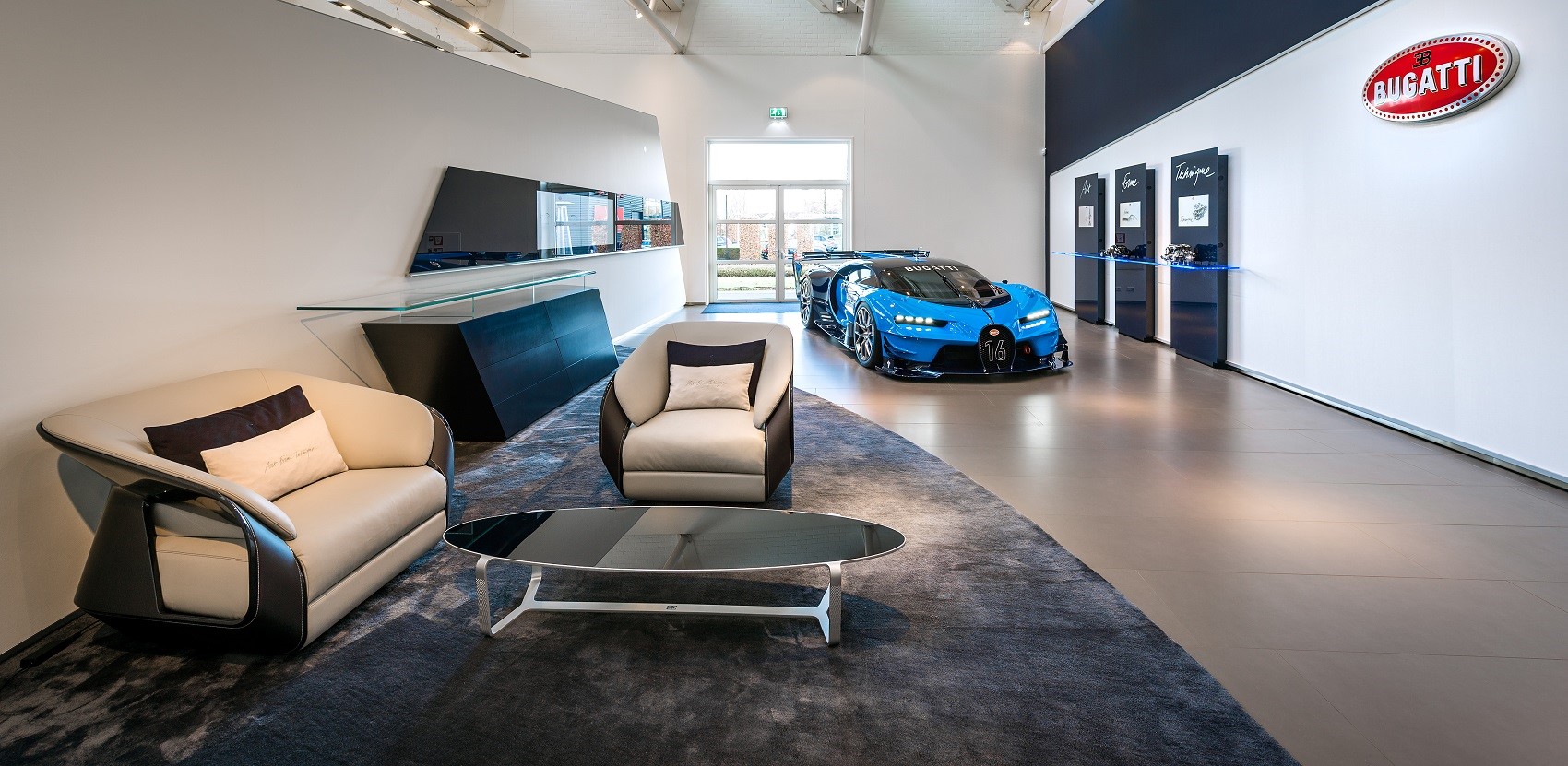
February 12, 2016
Together with its sales partner in the Netherlands, Pon's Automobielhandel B.V., Bugatti inaugurated a new showroom at the dealer’s headquarters in Leusden on Thursday evening. This is the first location of a Bugatti dealer in Europe with the new showroom design. The French super sports car maker had presented its newly developed corporate identity to dealers last autumn and has already opened the first showrooms in the USA. Bugatti currently has 27 dealers in 13 countries.
“Some of our most loyal customers live in the Netherlands,” said Dr. Stefan Brungs, Member of the Board of Management of Bugatti Automobiles S.A.S. responsible for Sales, Marketing and Brand Lifestyle, speaking to the many guests attending the inauguration. “The opening of this facility in Leusden is the first stage in a roll-out programme for our showrooms in Europe which will be implemented this year. I would like to thank our partners Pon for their highly considered commitment and the sustainable investment which they have made in our brand.“
Pon has succeeded in providing an appropriate home for the Bugatti Chiron in the Netherlands in good time ahead of the new model’s world debut at the Geneva International Motor Show in March.
The showroom, with floor space of 90 square metres, is located in 'Het Koopmanshuis', a central building on the Pon Campus in Leusden, near Amersfoort. It was here that the Pon family built up its business as a car dealer in the late 1920s. Pon has been an official sales partner of Bugatti since 2012.
Dealer’s address:
Bugatti Netherlands
'Het Koopmanshuis'
Zuiderinslag 6,
3833 BP Leusden
The Netherlands
Phone +31 33 434 16 98

February 12, 2016
The RETRO CLASSICS in Stuttgart will have an exclusive first with the presentation of a new Bugatti Royale „Esders“.
The replica roadster has been built over the last years in the Netherlands, by the same team who built the Bugatti Royale "Packard" replica which was presented at the Molsheim Festival in September 2011 seen below. This replica will be of the same magnificent quality, the main question remaining what question the longest roadster in the world will be, and how many differences can be spotted between it and the existing replica of the same car.
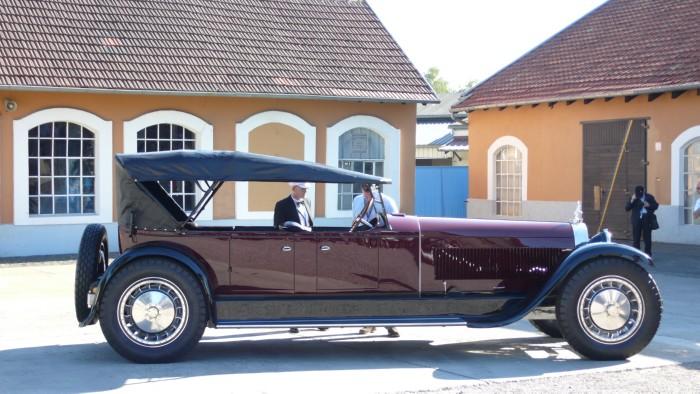
As the original body was destroyed, the existing photographs, only 12 of them, were used to make a 3D-model of the car and especially the body. The car is said to be reconstructed in every detail, until the last nut and bolt.
The RETRO CLASSICS® will take place from March 17 - 20, 2016 at the Messe Stuttgart, Germany.

January 26, 2016
Bugatti fans across the globe can rejoice as details on the new Chiron EB16, set to be unveiled in Geneva in March 2016, are finally revealed.
According to a December 28 post by Magazin ProDriverCZ, this more aggressive new model will feature 1500hp with maximum speeds reaching 467 km/h (290 mph) and an acceleration of 0-62 in 2.2 seconds. The same 8 litre W16 cylinder engine is retained, however with electrical turbochargers.
Bugatti is set to produce 100 pieces per year for 5 years capping off at 500 pieces total for this exclusive car. Already, Bugatti has received 130+ orders for the vehicle. The car is priced at an estimated $2.4 million.
To add to the anticipation, Bugatti released the above photo.
Eighty years after his father first ordered his treasured Bugatti Type 57C, Classic Driver dealer Simon Kidston undertook a personal journey to trace the car and bring it home, documented in this beautiful short film…
More than the sum of its parts...Video: Kidston TV, source: ClassicDriver.com

January 4, 2016
Keno Brothers auction, ‘Rolling Sculpture’, NYC
19th November 2015
1929 Bugatti Type 40,
Chassis: 40810,
Engine: 711,
Sold: $464,800 USD
The Bugatti that Crossed the Sahara
This Type 40 was built in 1929 and delivered to its first owner, M. Pierre de Brou de Lauriere in January, 1930. He promptly took it out for a spin with his wife… in the Sahara Desert on the Rallye d’Algers. This was the start of a long, be-ribboned life in racing for the car, continuing up to 2004 in the Le Mans Historic races. Today’s high level of interest in Bugatti automobiles derives from their rarity, meticulous build, astonishing design and beauty as well as an unparalleled history of excellence on road-racing courses and highways around the world. This car is one of the bright stars in that history.

January 2, 2016
From Yvon Mosser, France, I received a previously unpublished piece of footage from the 1930 Monaco Grand Prix, not a copy from PATHE or GAUMONT.
Dreyfus won this 2nd Monaco Grand Prix on a Bugatti T35B, while Chiron came second in a T35C. All 6 finishers were Bugattis, by the way, with 11 of the 19 starters retiring during this 3 hours 40 mins race!
Click the picture above, or this text to start the movie
Your computer must be able to play .avi movies, for example the VLC media player.

January 2, 2016
Harry John Hyams, the Englishman, who commissioned the construction of the Saoutchik Bugatti #50146 and who presumably has owned it all this years, died recently on December 19, 2015. He had been born on January 2, 1928. Perhaps we will once again have an opportunity to see this beautiful Bugatti in the next several months or years, as his estate is liquidated.
Obituary:
www.telegraph.co.uk
Thanks to:
John Dormer
Below: Harry Hyams in 1974 Photo: The Telegraph

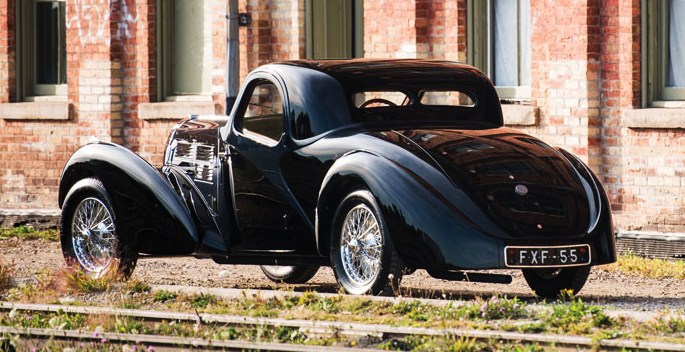
January 2, 2016
New York - Driven By Disruption RM Auction, December 10, 2015
1938 Bugatti Type 57C Atalante, estimate: $2,200,000 - $2,500,000 : Not Sold

November 29, 2015
This successor, I don't believe that the name is officially released by Bugatti, though everybody uses the name "Chiron" after another famous race driver from before WW2, and so will I.
These photo's seem to show a Chiron very close to it's final shape, though of course there will be some changes.
Specifications are quite constant for some while, with 1500HP, 1800Nm, delivered by the 8-litre W16 engine from the Veyron, assisted by a "Hybrid" system, thus some electrical engines, plus batteries. That will not really help to bring the weight down! From the photo's, the new Chiron will be the same size and wheelbase as the Veyron, enabling to re-use the major components.
0 - 100 kmh should be in 2.3 seconds, 0 - 300 kmh in 15 seconds, top speed around 450 kmh. Just what I need in the morning to get to work!
All this power will be brought to the pavement by Michelin Pilot Sport PAX tires, 20 inch at front, and 21v inch at the rear.
However, one big question mark remains, as a dark shadow over the introduction of the Chiron: Will Volkswagen pull the plug on Bugatti? VW loses a lot of money after their "problems" with diesel engines, and must make decisions to cut costs somewhere. Bugatti has been rumoured to be one of the possibilities to just do that. If VW pulls the plug, that would be probably the end for Bugatti, again.



The spirit of this event will be simplicity and friendship.

Information: Michel Weber,
Phone 00 33 388 957 377
E -MAIL : michel.weber33@sfr.fr
REGISTRATION IS ON ..

Once more a very nice field of pre-war sports and racing cars will roar and let their echo dance in the dunes of Zandvoort.
Even more good news: any owner of a sporty pre-war motorcar can participate as the concept of the event - just like Bentley Zandvoort_revival-800Vintage Revival Montlhéry - is a demo race without competitive speed element. Participants from Holland, United Kingdom, Belgium, Germany and France get together to have a grand weekend. The atmosphere is great with a dedicated pits tent for all pre-war participants. Possibly not unimportant to the company that you will bring. Amsterdam is only 15 miles away...! Organisation is by the Dutch Vintage Sportscar Club
Already inscribed Bugattis:
006 Mark Albada Jelgersma Nl 1935 Bugatti T57 Stelvio 008 Flip Klopper Nl 1928 Bugatti T35B 009 Lex Fabius Nl 1927 Bugatti T35c 018 Jeroen Albada Jelgersma Nl 1926 Bugatti T40 024 Tjerk Stapel Nl 1926 Bugatti 23 ] 040 Allard Legger Nl 1928 Bugatti Type 40 Grand Sport 052 Jeroen Hoep Nl 1927 Bugatti T35B
More info: www.dvscc.nl

June 25 - 26, 2016 Celebration of the 1923 French Grand Prix Tours, France
A Type 32 ‘Le Tank’ is set to return to Tours, site of the 1923 French Grand Prix, for the first time since competing there more than 90 years ago. The car will headline an historic revival held near the French town on 25-26 June.

The outlandish streamlined racer was involved in a close battle with Voisin’s equally striking Laboratoire cars and Henry Segrave’s Sunbeam, with the British driver eventually taking the spoils. Now, 93 years on, the Bugatti will return to do battle with a Laboritoire. In excess of 20,000 visitors are expected to pack into the historic medieval town of Chinon to view the spectacle.
“The 1923 Grand Prix was a race between extraordinary men and the kind of personalities that the automotive world has only seen a handful: Ettore Bugatti and Gabriel Voison,” said organiser Michel Loreille. “Their creations met on the race track and added a human element to the technical aspects of the sport, marking a turning point in the history of racing cars.

As many as 150 cars will set off from the Place Jeanne D’arc on the morning of 25 June, taking a 200km winding route around Touraine’s chateaux and vineyards. The following day will be dedicated to motor racing, including a parade of classic and vintage motorcycles around the Place Jeanne D’arc.
BAA member Bob Havens will hold a presentation on the Bugatti 100P Airplane, which he prepared with a tremendous amount of help from John Mellberg.
The presentation will be held on Monday, 25 July at 11:30 AM in the Skyscape theater in the museum. A second showing is scheduled for 29 July also at 11:30 AM in the Forum stage 7.
Furthermore, the Bugatti Type 57 Aerolithe replica will be shown alongside the 100P Airplane!

Memorial event.

Never publicly offered for sale - in present ownership for more than 30 years. Driven by Tazio Nuvolari at Brooklands in 1933, ex-Lord Howe.
Unseen in public for more than 20 years, a 1931 Bugatti Type 51 Grand Prix two-seat racer, originally owned by Lord Earl Howe and driven by Tazio Nuvolari has been consigned for Bonhams’s annual Quail Lodge auction during Monterey car week in August.
Never previously offered for public sale, the car has had only two owners since the 1950s. Its current owner has had the car for more than 30 years.

Francis Curzon, the fifth Earl Howe, was the first president of the British Racing Driver’s Club. He was a long-time Bugatti client and his Type 51 was one of the first to be delivered and carries the first chassis number in a series of only 40 cars, Bonhams said. That number is 51121.
The car was raced at various European tracks, including Brooklands, Donington, the Nurburgring, Montlhery, Monza and Reims, and in hill climbs including the Klausenrennen and Shelsley Walsh, where it set fast time of the day in 1932.
It also was entered four times in the grand prix race at Monte Carlo, where it finished fourth in 1932. Its drivers included Nuvolari and Piero Taruffi.
The car was campaigned in British Racing Green with Howe’s blue-and-silver stripes on the side of the body. It also featured very large fuel filler caps, presumably for faster pit stops.
Bugatti’s Type 51 cars have a link to American engineering and racer Harry Miller. The story goes that Ettore Bugatti was so impressed by Miller’s twin-cam engines that he traded three of his Type 43 cars for two Miller 91 cars. Bugatti had the cars dismantled to study their technology, then built his own version, the Type 51.
“As ever with Bugatti, the aesthetics in every form compliment the incredible power of this American-inspired, Franco-Italian supercharged 2.3-liter twin-cam racecar,” Bonhams said in its news release. “The result is a highly dynamic and potent sculpture of beauty capable of producing 160hp and a speed of 130 mph.”

Lot 251
1946 Bugatti Type 73C Grand Prix Monoposto
Chassis no. 73C 004 Engine no. 4
Estimate:
£270,000 - 320,000,
€340,000 - 400,000



The Type 73's all-alloy engine featured wet cylinder liners, a five-bearing crankshaft, and a detachable cylinder head, the latter a first for Bugatti, two camshafts and 16 valves, while the gearbox was an all-synchromesh four-speeder in the 73C(as the racing version would be named), it was initially planned to fit the road version with an automatic transmission designed by Ettore Bugatti himself. Although no road car was ever fitted either with this gearbox or the twin-camshaft engine, the realities of attempting to productionise the design dictated it would be fitted with a single camshaft engine and a Cotal gearbox. Writing to The Motor magazine in September 1945, R A Bouchard of Automobiles E Bugatti revealed that some 20 examples of the racing version were planned, though this ambition would prove impossible to fulfil in the difficult economic conditions of the immediately post-war years. Nevertheless, production got under way at the old La Licorne factory in Levallois, Paris, the Molsheim site being still unusable.



De Dobbeleer fitted a monoposto body based on proposals for Type 73C coachwork made in 1945 by Bugatti designer, Antoine Pichetto. The car was quickly sold on and de Dobbeleer then returned to Molsheim and acquired a second Type 73C. That car - '73C 002' - was sold in rolling chassis form to an American buyer and remained in the USA until 1973 when it was purchased by Tom Wheatcroft for his Donington Collection of Grand Prix cars. In fact, all five Type 73Cs survive: '73C 001' is in the Haruda Collection in Japan; '002' is back in the USA in private ownership; '003' is in the Cité de l'Automobile Museum in Mulhouse (formerly the Schlumpf Collection); '004' is the car offered here; and '005' is owned and raced by Tom Dark.









Brains Are Better Than Brawn
Targa Florio / 6th May 1928
Here we see the legendary Eliska (Madame) Junek waiting as her pit team works on her Bugatti Type 35B.
Eliska’s male counterparts didn’t think she was physically strong enough to be taken as a serious competitor. What they didn’t count on, however,
was that what she was missing in muscles, she more than made up for with brains. Before the race she walked the entire 108 kilometer (67 mile)
course and mapped out every detail. This intelligence helped her gain the lead position during the second lap of the race. She ended up placing fifth,
due to engine trouble, but still beat 25 other world-class male drivers to the finishing line.
Madame Junek unfortunately left the world of racing after her husband was tragically killed on the Nürburgring during the 1928 German Grand
Prix only two months later.
Artwork made using a special procedure using 3D photography, as can be seen on the website: www.unique-limited.com
Click for a large view!
I saw this one at Retromobile this year, in a large size. I was really surprised by the quality, combined with a known scene which you know can
not be photographed at the time!
The Concorso d’Eleganza Villa d’Este on Lake Como is the most exclusive location for historic automotive treasures. 2016 will again see owners and aficionados of rare automobiles and the most beautiful historic motorcycles coming together from Friday 20th May to Sunday 22nd May. The Corcorso d’Eleganza Villa d’Este owes its very special status among the world’s prestigious heritage events for historic vehicles to a number of elements. They include the elegance of the event, its long and illustrious tradition, its unrivalled flair at a beautiful location situated directly on the shores of Lake Como, and the small and select groups of participants.
BMW Group Classic and Villa d’Este have great pleasure in informing you that we have a few free spaces for participants in a total of nine vehicle classes which will be presented for the appraisal by the international and distinguished expert Jury. Perhaps one of your club members is in possession of a rare treasure which – following approval by the Selecting Committee – could receive a place in the starting line-up.

Chassis no. 38470, Engine no. 209
Estimate: $400,000 - $600,000
This 1927 Type 38A Bugatti, chassis number 38470, features a beautiful art deco Grand Sport body designed by Ettore. This car is one of only 39 Type 38A’s originally delivered with the inline 8 cylinder engine in supercharged form. Significantly, Bugatti 38470 has a known continuous history from new including a race at Brooklands in the hands of its famous first owner, L. G. Bachelier. That race was the start of a competition career that extended over multiple owners in Great Britain in the 1930’s. In more recent years, the current owners, the JWR Collection, have restored this car to original factory specifications, both mechanically and cosmetically. Their efforts were rewarded when this Type 38A Bugatti received an award in class at Pebble Beach in 1993.
Former Owners
Bachelier was a famous Bugatti owner in Great Britain being one of the founding members of their Bugatti Owners Club. Over the years he owned a total of nine Bugattis beginning with a Type 23 Brescia Bugatti, chassis 2533. At one point he owned the ex-Junek Type 35 Grand Prix car, chassis 4613. His last Bugatti was a Type 54 Grand Prix car, chassis 54205, which featured the supercharged 4.9 liter engine. Bachelier famously converted this Type 54 to a road-going sports car by creating a roadster body for it in the style of the Type 55 Jean Bugatti roadsters. The resulting car was a stunning beauty and arguably the fastest road going automobile in Great Britain at the time of its completion in late 1937. Unfortunately Bachelier died in June 1937 just before the car was finished. This car is universally known as the Bachelier Roadster. It spent many years in the US and was raced on the streets of Watkins Glen in 1950 in the capable hands of Hal Ullrich.
Bachelier raced his Type 38 at Brooklands in the JCC High Speed Trials in July 1929. In the 1930 he sold it to Denis Evans who raced it in the BARC Open Meeting Mountain Handicap in 1931 and the JCC High Speed Trials at Brooklands in 1931 and 1932. The Type 38 then went to Child who eventually sold it to B. Rees. By this time the chassis had been shortened to convert the car to a two-seater and the engine had been replaced, fortunately with another genuine Bugatti unit, number 209, ex 38275. This engine ran with twin SU carburetors and was not supercharged. Subsequently this car came into the hands of Derby, then Gilbert and then John Anderson in London.
Bugatti 38470 was then exported to the US, still in its shortened wheelbase form. It was first owned in the US by Steingold, then Fountain and then Kirk White. In 1973 it was owned by Walter Stedeford and then by Richard Winer of Fort Lauderdale, Florida. The next owner was Dr. Terry Bennett of Hampton Falls, New Hampshire. Dr. Bennett had an interesting collection of cars and in 1991 decided to sell the majority of them at auction with the proceeds going to benefit his alma mater, the Harvard University School of Medicine. At the auction, Bugatti 38470, still in shortened wheelbase form, was acquired by the current owners, the JWR Collection of Pennsylvania.
A major restoration of 38470 was then commissioned with the intention of bring it back to original factory specifications in all respects. The mechanical work was performed by Don Koleman’s Competition Motors in New Hampshire. The first priority was to return the original chassis to its correct long wheelbase form. Competition Motors then upgraded the car’s second engine, number 209, to supercharged form via the fortunate purchase of an original Bugatti supercharger. The body work was sent to Robert Lorkowski of L’Cars in Wisconsin, and they expertly crafted a new body around the small amount of original bits that survived.
The work was completed in early 1993, and the owners and their team were rewarded later that year when Bugatti 38470 won a prize in class at the Pebble Beach Concours d’Elegance. Since then this Bugatti Type 38A has attended many meetings and has won numerous concours awards.

Chassis no. 40748, Engine no. 772
Estimate: $425,000 - $500,000
The Bugatti Type 40 was introduced in 1926 as a nimble and speedy model in the current factory lineup. An improved model, the Type 40A, was produced in 1930. The Types 40 and 40A were a bit smaller and more moderately priced than other Bugatti offerings at the time. A grand total of 830 were produced between 1926 and 1930, including about 50 Type 40A’s in 1930. It is estimated that around 200 Type 40’s and Type 40A’s have survived to this day.
Former Owners
Not much is currently known about this Bugatti’s Parisian life. However, Dominique Lamberjack, the Parisian agent, attached a plate to the car, and so it was undoubtedly owned by him at some point. The car remained in France during the war as evidenced by two additional plates that were attached: one from the Automobile Club France du Nord in 1942 and another from the German Totenkopf and Hakenkreuz. This Type 40A Bugatti came to the US after the war and was discovered in southern California when an old house was demolished in Chavez Ravine for the development of the baseball park for the Los Angeles Dodgers. The car was purchased by Rudi Van Daalen Wetters on July 20, 1961. At that time, the car had the French license plate 69 JG 75, but it was subsequently registered in California as UBK 795. Rudi Van Daalen Wetters was a true Bugatti enthusiast and expert who had multiple Bugattis over the course of his life. With his passing in 1999, the Type 40A was inherited by Ria Van Daalen Wetters, his wife and a fellow Bugatti enthusiast. She continues to own the car to this day. The Type 40A was restored to Concours standards in 2004 and had its engine rebuilt in 2015 by High Mountain Classics of Greeley, Colorado.

May 14, 2016 Bonhams Auction - The Monaco Sale 'Les Grandes Marques à Monaco' Monte Carlo
Preview lot
1925 BUGATTI TYPE 35 GRAND PRIX TWO-SEATER
Chassis no. 4450
Current ownership since 1963, The ex-Lieutenant Commander Glen Kidston, George Duller, T.V.G. SelbyT 35, Chassis no. 4450
Estimates:
€1 million - 1.5 million
£770,000 - 1.2 million
US$ 1.1 million - 1.7 million
More info on Bonhams Website
Photo: George Duller Essex MC October 1925 Brooklands
Lot 139
1939 Bugatti Type 57 Cabriolet by Gangloff

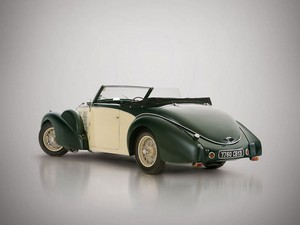

Estimate: €500.000 - €600.000, Without Reserve
135 bhp, 3,257 cc DOHC inline eight-cylinder engine, four-speed manual transmission with reverse, live front axle with semi-elliptical leaf spring suspension, live rear axle with inverted quarter-elliptical leaf spring suspension, and four-wheel Lockheed hydraulic drum brakes. Wheelbase: 3,300 mm
The annals of automotive history are filled with characters whose life stories are more fascinating than the best of fiction. Certainly among these is the existence of Jean-Pierre Wimille. Born into a family steeped in the scent of Castrol and hot metal, Wimille was the son of the motoring writer for Le Petit Parisien. He made his entry into Grand Prix racing at the wheel of a Bugatti Type 37A in 1930, and he never looked back. For the remainder of the decade, he was a frequent sight at the world’s most important races, and in most of these, he drove a Bugatti.


WIMILLE’S DEMONSTRATOR
This Type 57, chassis 57731, was one of 11 late-production chassis produced in the autumn of 1938 as 1939 models. By the time this chassis was built, Bugatti was focusing the energy of its factory on strong-selling, practical body styles such as the Galibier saloon, and it was increasingly outsourcing production of the more specialized bodies to their favoured coachbuilder, Gangloff of Colmar.
The four-passenger cabriolet body built for this car was drawn by Lucien Schlatter and built by Gangloff as a “special cabriolet”. In much of its specifications, the car was similar to the limited-production Stelvio design but incorporated several detail differences in its lines. Most Stelvios built in this period were made by Gangloff employee Schmitt, but this one was made by Zubern, further indicating its unique “one-off” status. Features such as the sharply raked windshield, single side-mounted spare, and the treatment of the rear deck were unusual; the car also incorporated desirable styling touches common to the late Type 57s, including front “bumperettes” and low headlamps blended into the front fenders.
Following its completion in October 1938, the Bugatti was dispatched to the 16th Salon International de l’Automobile in Geneva, Switzerland, in early 1939, where it was displayed on the factory stand. It was subsequently utilized as a factory demonstrator and made available to Jean-Pierre Wimille, wearing factory registration plates 5265-NV2. Given his favoured status with the factory as one of its finest and most active drivers, Wimille often had the latest and best Bugatti at his disposal; chassis number 57731 was one of these.
Early post-war history of the car is not recorded, though Bugatti historian Kees Jansen notes it was registered in Rouen, France, in 1950 as 710 F 76. It later made its way to the South of that country, and in 1963, it was purchased there by well-known Bugatti trader Paul Sac, a contemporary and colleague of the famed Jean de Dobbeleer. At the time, the car was finished in black and yellow and registered as 7760 CB 13. Sac subsequently sold the car to the Quattroruote Collection in 1964, and it has remained a centrepiece of the Collection ever since—a remarkable period of over 50 years in single ownership, virtually unparalleled among Bugattis of this era.
Currently finished in cream and black, the car remains a very authentic older restoration and in very presentable cosmetic and mechanical condition throughout. In inspection, the engine number stampings are noted as being correct factory stampings, and the car can be confirmed to have its original engine, with which it was delivered in 1939. Similarly, the “57” of the chassis number on the engine and chassis plate are original, but the “731” on the plate is a later stamping, likely (according to Jansen) made very early in the life of the car.
The cabriolet’s rich history is described in the Italian Bugatti Register (p. 151), in Hugh Conway’s 1962 Bugatti Register (p. 77), and in the 1973 New Bugatti Register. Furthermore, it is recorded in Conway’s 1989 Bugatti Magnum, although erroneously listed there as still being located in France.
A Bugatti of exceptional provenance and quality, this is one of the few products of the company to have been both a significant show car and the steed of a legendary driver. It is one of the most historically significant Type 57s offered in recent memory and a car which RM Sotheby’s is quite proud to pass to a new owner here in Monaco today.

Delivered new to New York
1937 BUGATTI TYPE 57SC SPORTS TOURER
Coachwork by Vanden Plas
Chassis no. 57541, Engine no. 29S
Estimate 8 - 12 million euro
3,257cc DOHC Supercharged 8-Cylinder Engine
Stromberg Carburetor and Roots-type Supercharger
200bhp at 4,500rpm
4-Speed Manual Transmission
Low-slung Leaf Spring Suspension
4-Wheel Hydraulic Drum Brakes
THE BUGATTI TYPE 57
"The car sped along at 80 mph with the comfort and quietness one associates with the Type 57... We were quite willing to believe that Jean Bugatti has achieved the 435 kilometers to Paris in just under 3½ hours in the Type 57 - an average of 77mph..." - Motor Sport, May 1939, writing about the normally-aspirated Bugatti Type 57.
Introduced in 1934, the Type 57 marked Jean Bugatti's emergence as Bugatti's leader and creative driving force. It was the first new model built under his direction and it incorporated many features new to Bugatti. Its dual overhead camshaft eight-cylinder engine had dimensions of 72x100mm, offering 3,257cc displacement, with a five main bearing crankshaft. The camshafts were driven by a train of helical-tooth gears at the engine's rear with a further crankshaft bearing behind them. Finger cam followers minimized side thrust on the valve stems. The Type 57 also marked Bugatti's first use of a transmission fixed to the engine crankcase and a single plate clutch. The top three gears in the four-speed gearbox were constant mesh. A proper Bugatti hollow tube live front axle was suspended by semi-elliptical front and reversed quarter-elliptical rear leaf springs with cable-operated mechanical drum brakes.
Despite financial problems, development of the Type 57 continued with the introduction of a stiffened frame and rubber-mounted engine, along with the supercharged Type 57C model in 1936. Driven by the camshaft drive at the rear of the engine, the Roots-type supercharger ran at 1.17 times engine speed. This provided a 5-6 psi boost and a healthy 160 bhp which made close to 120 mph possible. The Type 57 in all its forms attracted discerning owners who were only satisfied with the best, among them land speed record holder Sir Malcolm Campbell, who wrote: "If I was asked to give my opinion as to the best all-round super-sports car which is available on the market today, I should, without any hesitation whatever, say it was the 3.3 Bugatti... it cannot fail to attract the connoisseur or those who know how to handle the thoroughbred. It is a car in a class by itself."
THE TYPE 57 S AND SC
This was the already fantastic chassis that spawned the Type 57S, where the S stood for surbaissé, or lowered – virtually a Grand Prix car in touring car guise. Although the 57S shared some features with its progenitor, the differences between the two models placed the 57S in a league of its own. Mechanical excellence was achieved by fitting a modified crankcase with dry sump lubrication derived from the T59 GP car, including separate scavenge and pressure oil pumps supplied from a 20 liter tank. High compression pistons gave the new engine a significant performance edge, and the clutch was reinforced to cope with the extra output. Ignition was by a Scintilla Vertex magneto driven from the left-hand camshaft. With its low weight, abundant power and small frontal area, the 57S had suddenly become a very, very fast automobile.
However, the fundamental difference between the 57S and the standard Type 57 lay in the low-slung frame design with its shorter wheelbase. The rear axle passed through the frame, while de Ram shock absorbers provided damping cleverly engineered to increase with speed. This new low chassis and the distinctive 57S vee-shaped radiator was a gift to the stylist, and the Jean Bugatti-influenced Atalante Coupé styling that was fitted to 17 of the 57S chassis, blended impeccably with the sculpted radiator design. Production was very limited. A mere 48 Type 57S chassis were built until the outbreak of hostilities. Two of these were 57SC models, fitted with a supercharger by the factory to create the ultimate-specification 200 bhp prewar French supercar. Along with the legendary Alfa-Romeo 8C 2900, the Type 57SC was quite simply the fastest road car in the world. With these extraordinary credentials, it is little wonder then that the 57S has been held in awe across the decades by collectors and enthusiasts alike, right up to the present day.
Even rarer than the Type 57S chassis that were bodied with Bugatti factory designs built by Gangloff in Colmar, were the very few that were handed over to outside coachbuilders. The car offered here is one of these ultimately rare cars. The Carrosserie Van den Plas was incorporated in Brussels in 1898. Automobile body manufacture commenced in 1900, and the company grew quickly. From about 1906, Metallurgique cars with Van den Plas bodies were imported into England by a company called Warwick Wright, which acquired the license to manufacture Van den Plas bodies and designs for the United Kingdom in 1910. In 1913, Vanden Plas (in two words) Ltd. was incorporated which then became a coachbuilding company in its own right.
The two companies led separate lives, but co-existed peacefully over the years. From 1924 to 1931, the English Vanden Plas company became famous for its rakish bodies on W.O. Bentley chassis, of which about 700 were built. With its reputation for quality coachwork well-established, Vanden Plas also bodied a number of Alvis, Armstrong Siddeley, Bentley, Daimler, Lagonda, and Rolls-Royce chassis in the 1930s. Vanden Plas bodied a total of two Type 57S chassis, namely the subject car and chassis 57572 which was given two-seater cabriolet coachwork in the autumn of 1937.
THE MOTORCAR OFFERED
The history of 57541 described here relies on the work of Bugatti expert Pierre-Yves Laugier, as well as on that of Bernhard Simon and Julius Kruta. All three have published chassis-by-chassis accounts of the Type 57S, which have been used.
George Rand, who had recently been appointed Bugatti agent in New York, ordered 57541 via Colonel Sorel, the London agent on Brixton Road. The chassis was sent to Vanden Plas and given a four-seat touring-roadster body no. 3595. Painted gray with red accents, the cost of this exquisite bolide was £ 275. Bodied in the classic minimalistic British style with sporting cut-down doors, 57541 resembles the Vanden Plas 4 1/4-liter Bentley Tourer body no. 3340 delivered to Malcolm Campbell in April 1936, as well as the 4.3-liter short chassis Alvis body no. 3588 built in 1937. Historically and stylistically, these three bodies can trace their lineage directly back to the great Vanden Plas-bodied W.O. Bentleys from the late 1920s. Colonel Sorel must have been justifiably happy with the result, as 57541 was pictured in the company's 1937-1938 catalog.
George Rand had 57541 shipped to New York where it is likely that it was used in the A.R.C.A. races on September 25, 1937. Period images exist of the car taken at the Roosevelt Raceway race in New York without the fender skirts it was fitted with initially. Rand was unable to find a buyer for the car, and it was shipped back to England and shown on the Bugatti stand at the London Motor Show held at the Olympia from October 13 to 22, 1938. On November 3, 1938, it was registered with the number FGW 384. The first English owner remains unknown. It is likely that 57541 remained in England, but according to Pierre-Yves Laugier, it is possible that by the end of 1938, 57541 was in the ownership of Herman H. Harjes, Jr., director of the Harjes and Morgan Bank on the Place Vendôme in Paris.
57541 vanished from sight during the hostilities, but towards the end of the war, it appeared for sale at the Continental Cars garage which was owned by Rodney Clarke, and it is likely that it was given registration number DXP 970 in 1947. That same year, the car had no less than three owners, namely Rodney Clarke, Brian Finglass, and Sir Alfred McAlpine, all of whom were managers of Continental Cars. Using Jack Bartlett as intermediary, they sold 57541 to Jack Robinson, who exported it to Trinidad, where it was registered as PB 371. According to Pierre-Yves Laugier, Robinson stated in a 1952 issue of Bugantics that when he bought the car through Bartlett, it was equipped with a Type 35B 3-blade racing supercharger. Robinson also noted that major work had been done to the car including fitting a new crankshaft, crankcase, cylinder block, pistons and connecting rods. In 1952, the car was completely overhauled, but its original gray color was kept. As Laugier succinctly states, "After its restoration, Robinson made the XK120 Jaguars pay dearly at the Trinidad Aerodrome, where he reached speeds of more than 180 km/h."
Robinson kept 57541 for more than thirty years and sold it to Peter Agg in 1985, with Leonard Potter possibly acting as middle man. Via his Trojan company, Agg undertook a complete restoration of the car. The engine was given to Crosthwaite and Gardner, who replaced the 35B supercharger with a correct Type 57, thereby bringing 57541 up to factory correct 57SC specification. Hydraulic brakes were fitted and the car was repainted in the light metallic blue color that it wears today. Agg took great joy in using 57541, and he was regularly seen participating at the Prescott hill climbs and various circuits. In 1995, the car was sold to its present owner, who has retained it for the past 20 years.
Remarkably, 57541 has a virtually unbroken chain of protective owners who have taken extremely good care of this automotive jewel since it left the factory. Factor in the unbeatable combination of its unique coach built body and genuine 1930s supercar underpinnings, and the result is truly a heady cocktail. The Bugatti Type 57S embodies the highest standards in road holding, engineering refinement and maximum performance in a prewar car. It also displays a sheer mechanical elegance is the very pinnacle of mid-1930s aesthetic finesse. One can lose oneself, just contemplating the gorgeous engine compartment. The Type 57S ticks every box – it is in many ways the ultimate pre-war supercar, and in SC form, certainly faster than virtually anything else on the road at the time. The production run of the 57S was brief as manufacturing costs were high, and a devastating war intervened. Rarest of the rare, 57541 represents a unique opportunity for an enlightened collector to acquire one of the greatest classic cars in the world.
The full production and current ownership record is summarized by Bernhard Simon and Julius Kruta in their reference work on the model. The list represents a stunning statement of the importance and exceptional esteem that collectors have held these cars in almost from new. When such things were still possible the Schlumpf brothers cleverly snapped up no fewer than 9 of them, precluding 20% of the production from changing hands again. Trend setting collector Ralph Lauren is one who can count 2 in his definitive stable, the majestic Atlantic Coupe as well as a convertible for example. As one analyzes this list today the potential to secure one, let alone an open car becomes so much more daunting, given that so many are now in long term ownerships or Institutional collections. A measure of this might well be the fact that it is 17 years ago since a convertible was offered publicly.

 Lot 157
Lot 157
1925 Bugatti Type 30 Tourer
Chassis no. 4725,
Engine no. 418,
Gearbox no. 1420
Estimate: $500,000 - $650,000
100 bhp, 1,991 cc SOHC inline eight-cylinder engine with dual Solex carburetors, four-speed manual transmission, live front axle with semi-elliptic leaf-spring front suspension, live rear axle with quarter-elliptic leaf-spring suspension, and front hydraulic and rear mechanical drum brakes. Wheelbase: 112 in.
The Type 30’s engineering was not as exciting as subsequent Bugattis, nor was it fast; where it excelled was in jewel-like mechanical sophistication. The engine sported a barrel-type crankcase under a pair of fixed-head cylinder blocks, surmounted by a single cambox in which the overhead camshaft operated the valves by finger-type rockers to the two inlets and a single exhaust valve per cylinder. Carburetion was supplied by a pair of either Zenith or Solex carburetors; ignition was initially by magneto, with a coil used for later cars. A fine four-speed gearbox with right-hand change lever and mesh gears, shifting through a wet multi-plate clutch, ensured the remarkably rapid gear change for which all Bugattis were renowned. The I-beam front axle was new and substantially constructed, and hydraulic front brakes were installed, with the rear drums considerably larger than those at the front.
Almost exactly 600 examples of the Type 30 were produced between 1922 and early 1926.
CHASSIS NUMBER 4725
Chassis 4725, offered here, is accompanied by a report compiled by Dutch Bugatti expert Kees Jansen. Jansen notes that the car was ordered by Bugatti agent Dubuisson of St. Quintin for his customer, Mr. Chavel, and that the chassis was produced in January of 1926. Dubuisson purchased the rolling chassis only, with an unknown coachbuilder producing the elegant four-passenger open Tourer body, with two doors: one on the left, for the front passenger, and one on the right rear! Importantly, early photographs depict the car with the sexy rakish vee’d windshield that it still wears today, showing that it has had this feature since new. The car was driven on garage plates 1651 WW5 by Bugatti racing driver, Louis Charavel, who competed successfully under the pseudonym of “Sabipa.”
Delivered to Monsieur Chavel, the car remained with his family until 1960, a remarkable 35 years of continuous ownership. It was subsequently sold to J.P. Léger of Dreux. A photograph, published in Yan Verdier’s Y Une Vie pour Bugatti, shows the car in this period at Henri Novo’s famous Bugatti garage, with the engine removed; it was at this point that the current engine, 418, another correct Type 30 unit, was installed. Also in this period, the car was refinished in its present color scheme of yellow with black cycle fenders and wire wheels.
The next known owner was Henri Chambon of Clermont Ferrand, who purchased the car in 1972 and registered it as 7892 QG 63, using it at the International Bugatti Meeting in Denmark five years later. It next passed to Bernard Viallon, a well-known collector whose stable included a number of Bugattis. Viallon’s cars were famously used for color illustrations in one of the most famous works on the Bugatti marque, Bugatti Magnum, written by the renowned Bugatti historian Hugh Conway and published in 1989; this car appears on pages 111 and 112.
The car has now been a resident of its present owner’s collection for two decades and during that time has seldom been shown in public. It retains its original frame, transmission number 1420 (a high number due to the fact that the same type of transmission was also used on the Brescias), and original rear axle number 588. The finishes throughout are in good condition, including the attractive paintwork of the body, older but overall well-preserved brown leather upholstery, rich inner wood capping along the sides of the body and dashboard, and a black cloth top that is in good shape. Marchal headlamps accentuate the overall sporting appearance, while the underside and engine bay are presentable and correct.
“Cute as a button,” this Type 30 is a petite little eight-cylinder jewel that would be great fun for a new owner. It is appealing both to the serious Bugatti enthusiast and simply to anyone who enjoys beautiful lines on a superbly engineered chassis.

 Lot 129
Lot 129
1936 Bugatti Type 57 Stelvio
Chassis no. 57406,
Engine no. 286,
Gearbox no. 68C
Estimate: $900,000 - $1,200,000
135 bhp, 3,257 cc DOHC inline eight-cylinder engine, four-speed manual transmission, live front axle with semi-elliptic leaf springs, live rear axle with inverted quarter-elliptic leaf springs, and four-wheel hydraulic drum brakes. Wheelbase: 130 in.
In the world of East Coast automobile collecting, especially in Florida, few people stood as tall for as long as the late Alexander E. Ulmann. His name is, of course, synonymous with Sebring, the first American automotive endurance race, which he established in December 1950, as well as with early efforts to establish the U.S. Grand Prix. However, his efforts in early U.S. automobile enthusiasm were not strictly limited to being a track-day impresario. Raised around Russia’s hydroelectric power plants and possessor of a Masters from MIT under Dean Fales, his business success in the burgeoning aeronautic and aerospace industries funded collecting that was as diverse as his life. Mercedes of 1908 and 1914 occupied the Ulmann garage, as did the famed marque Hispano-Suiza; but of his many automotive passions, few were as warm or as long-lasting as that for his Bugatti Type 57, chassis number 57406.
According to Bugatti historian Kees Jansen, Ulmann’s Type 57 was built in April 1936; its body was, and remains, a four-passenger Stelvio, the attractive Jean Bugatti–designed cabriolet with its distinctive pontoon fenders and Atalante-like rounded tail. Typical of Bugatti, the Stelvio’s design evolved during Type 57 production. In 1935–36, the Stelvio sported a folding windshield and a top that would fold nearly flat and out-of-sight into a “cut-out” provided for it at the rear of the body. The result was streamlined, attractive, and sporting. It was an automobile that just seemed to have been designed to show off. Bugatti agreed, and sent chassis 57406 to the Nantes Fair, an international trade exhibition for everything from farm equipment to sports cars, which still exists today. On August 8, 1936, the car was sold to its original owner, R. Petit.
Subsequently, the car made its way into the ownership of a Mr. Ferrand, by which time it had been upgraded with the later-style headlamps, integrated into the front fenders, as well as spats over the rear wheels. Period photographs from the 1940s, which are on file, show the car already fitted with these features, which in their design and construction seem very professional and true to later 1937–39 Bugattis. In addition, the car was also fitted with the front “moustache” bumpers, as well as Lockheed hydraulic brakes, which were a common upgrade to earlier cable-brake cars. All of this indicates that these modifications were either done by the factory or by a Bugatti agent.
The Bugatti was sold by Mr. Ferrand to Jacques Dufilho, then a well-known actor living in the Latin Quarter of Paris. Additional very charming photographs on file depict the car during Mr. Dufilho’s long-term ownership, with members of his family obviously enjoying its good company. It was this last French owner who would sell the car, in 1974, to Alec Ulmann, in whose collection it would be maintained for the rest of the great sportsman’s life. He drove the car without the rear fender spats and refinished in light blue and black, as shown in a photograph taken in New York early in his ownership.
The American Bugatti Registers by Andy Rheault and Sandy Leith note continued ownership by Mr. Ulmann until his passing in 1986. The Bugatti was retained by his widow, Mary, for two years and then was sold to a prominent collection on the West Coast. The car was then restored to its present appearance, updating its Ulmann two-tone royal blue and black “sweep panel” livery while fitting pale grey leather upholstery as a breathtaking contrast and reinstalling the “spats” on the rear wheels. The wire wheels were chromed, as had been available from Bugatti in 1937.
Offered today from a long-term caretaker of the past two decades, the Ulmann Bugatti still shows presentably throughout, although it would benefit from touch-ups to the finish today. It retains its original engine, number 286, and transmission, number 68C, from this supercharged Stelvio, as well as its original rear axle number 427; the internal frame number is 50. The dashboard carries what appear to be the original gauges, with the exception of a new Jaeger tachometer (undoubtedly useful in spirited driving), and the odometer records 1,047 kilometers, believed to be the distance traveled since the restoration.
For the collector who appreciates beauty, quality, and provenance, the availability of this Stelvio marks the opportunity to follow in the tradition of another similarly-minded sportsman—its previous owner, the great Florida icon, Alec Ulmann.

New Bugatti T41 Royale Esders Roadster Replica to be presented
The RETRO CLASSICS in Stuttgart will have an exclusive first with the presentation of a new Bugatti Royale „Esders“.
The replica roadster has been built over the last 6 years in the Netherlands, by the same team who built the Bugatti Royale "Packard" replica seen below which was presented at the Molsheim Festival in September 2011. This replica will be of the same magnificent quality, the main question remaining what question the longest roadster in the world will be, and how many differences can be spotted between it and the existing replica of the same car.

As the original body was destroyed, the existing photographs, only 12 of them, were used to make a 3D-model of the car and especially the body. The car is said to be reconstructed in every detail, until the last nut and bolt.

Réunion à Molsheim
This large and impressive oil on canvas, dated 2013, was created by renowned artist Dexter Brown, working under the pseudonym de Bruyne. De Bruyne is
regarded as the most preeminent living automobile artist and has created a number of large-scale oil paintings in the romantic Impressionist style.
His paintings are highly sought after and are held in important private collections across the United States, Europe, and Japan.
The original was recently sold in the New York - Driven By Disruption - RM Auction on 10 December 2015, for $23,000.
The exhibition is in the Museum Autovision
 January 28, 2016 RM Sotheby Auctions Phoenix, Arizona, USA
January 28, 2016 RM Sotheby Auctions Phoenix, Arizona, USALot 128; 1931 Bugatti Type 49 Roadster by Gangloff
Chassis no. 49431
Engine no. 275,
Body no. 393,
Gearbox no. 277,
Rear axle no. 277
Estimate: $900,000 - $1,100,000
This car was one of two identical examples ordered at the same time by Bugatti agent Antonin Joly et Frères of Tunis, and it was sent to Alsatian coachbuilders Gangloff, that great favorite of the Bugatti factory, for their especially lovely roadster body with a “dickey” seat, folding windshield, and artfully flowing fenders. It is important to note that this very sporty coachwork actually predates the similar design credited to Jean Bugatti for the later Type 55! With body number 393 installed, the car was subsequently delivered by Joly to a client who wished to register it in France.
The history of this Type 49 picks up in 1955 in Paris, where, still very original and intact, it was registered as 579 DW 75. Several years later, the attractive little roadster participated in the 1958 International Bugatti Rally, organized by the Dutch Bugatti Club, which included stops at Château d’Ermenonville, the home of Ettore’s daughter Lydia, as well as Le Mans. It also appeared the same year in a French film, La Chronique Provenciale.
In 1967, the Type 49 came up for sale at Henri Novo’s garage in Montrouge, Paris, and was subsequently sold to Jess Pourret, the well-known collector and historian famous for his works on Ferrari. Monsieur Pourret reported the car to Bugatti historian Hugh Conway as 49431, with engine number 275, in 1974, indicating that it had retained both its original identity and engine up to this point. He participated with the car in a Bugatti rally at Bec Hellouin in 1968 and at a Bugatti Owners Club meeting at Prescott in 1969. Later, the Bugatti became one of many wonderful automobiles owned by the noted French collector Michel Seydoux, before its eventual sale through well-known broker Edgar Bensoussan.
At some point, the Type 49 gained the serial number tag 49122, however, in studying the Bugatti and its components, there is no question that this is actually 49431. Aside from the replacement of the original carburetor with a Weber unit and the addition of an auxiliary radiator under the chassis, there is no evidence of major changes made to the car during its long history.
The woodwork in the body bears the Gangloff number 393, and the drivetrain appears to be completely matching with engine number 275, transmission number 277, and rear axle number 277. The internal frame number is 1179, which, at a glance, appears to be a late Type 44 number, however, Jansen notes that, by the time of this car’s production in late 1931, the short-wheelbase Type 49 was available only by special order. Rather than manufacture a new frame, the factory would use one of the leftover stock of the Type 44 chassis, which were of the same dimensions and virtually identical, so this last major component appears to be original to 49431 as well.
 January 29 - 30, 2016 Gooding & Company,
The Scottsdale Auctions Scottsdale, Arizona, USA
January 29 - 30, 2016 Gooding & Company,
The Scottsdale Auctions Scottsdale, Arizona, USALot 143; 1931 Bugatti Type 49 Grand Sport
The 1931 Olympia Motor Show Car | Two Private Owners from New
Coachwork by A.P. Compton & Co.
Estimate: $550,000 - $750,000
Chassis: 49119
Engine: L12
Arguably the Finest Ettore Bugatti-Designed Touring Car Early Type 49 with Matching Numbers Engine and Sporting Original Coachwork Displayed on the Bugatti Stand at the 1931 Olympia Motor Show Exceptional Provenance, Just Two Registered Owners from New Beautifully Preserved, Largely Original Leather Upholstery and Canvas Top



 February 5, 2016 Artcurial Auction Retromobile, Paris, France
February 5, 2016 Artcurial Auction Retromobile, Paris, FranceLot 183; 1920 Bugatti Type 13
Châssis n° 981,
Moteur n° 538
Estimation 360 000 - 420 000 €
When he designed his four cylinder, 16 valve 1.5 litre engine in 1914, Ettore Bugatti unveiled a masterpiece which powered his cars to the first four places in the Brescia Grand Prix of 1921. And that is why they were named after this city. The car we offer today is considered to be a Type 13 and this is confirmed by David Sewell's report which is authenticated by both the Bugatti Owners Club and by the Bugatti archivist, Julius Kruta.
According to the factory records Chassis No 981 fitted with Engine No 538 and Gearbox No 488 was a Type 23/27 delivered on 5th September 1920 to Louis Pabanel of Paris who was the Diatto's agent for France. Type 23 denotes a 2.55 metre wheelbase chassis whilst Type 27 denotes the 16 valve engine which was designed for racing in 1914, but did not enter production until February 1920 when it superseded the previous 8 valve model introduced in 1910. A Type 23/27 therefore indicates a Type 23 chassis fitted with the new 16 valve engine.
Shortly after the end of the World War I, Bugatti had entered into a contractual agreement with Pabanel to supply him with 50 Bugatti chassis, complete except for radiators and bulkheads, for him to market as Diatto-Bugattis fitted with rectangular Diatto radiators. Production of the new 16 valve model started at Chassis No 901, and the last of the fifty Diatto-Bugattis was Chassis No 1031 delivered in December 1920.
The first owner of this car is not recorded, nor is its original bodywork, but by June 1922 it was registered in the then extensive Marseille region with the number 2775 M 2,and retained this number after moving to Draguignan, 70 miles north-east of Marseille in September 1926. On 16th October 1928 it was sold to Edmond Autran of Toulon, in whose name it was registered 291 YU. In the new French registration system introduced that month, Toulon was in the Var region, 1 YU being the first registration number issued there.
A later French owner was named Pesnin, after which there is a long gap in the car's history until it reappears in the early Sixties with Weerte Ley of Cleveland, Ohio. It subsequently passed on the early Seventies to Paul Moser of Santa Barbara, California in whose name it is listed in the 1978 American Bugatti Register as a Type 22/23 (not sure of its wheelbase!) with a two seater roadster body but with no recorded registration number.
In the second edition of the American Bugatti Register, published in 1988, it was listed as untraced, but it was subsequently discovered that by 1989 at the latest it had gone to Japan to be owned by Yoshiyuki Hayashi, in whose name it is listed (as a Type 22) in a Japanese Bugatti Register dated January 1995. Later that year the car returned to the USA and was owned first by Rick Rawlins, then by American Bugatti Club archivist Leo Keoshian of Palo Alto, California. In 2012, the car was purchased in the Pebble Beach auctions by its actual owner, an Italian collector dreaming of racing the Mille Miglia with it.
Like at least two other Diatto-Bugattis it was eventually fitted with a Bugatti radiator. It is unclear exactly when its chassis frame was shortened to become a (2.0 metre wheelbase) Type 13, but presumably either whilst in Japan or shortly after its return to the USA. However there is no doubt whatsoever that this car is Chassis No 981 dating from 1920 and that it retains its original Engine No. 538, Gearbox No 488 and most probably its rear axle which, like all examples of this model, were never numbered.
Recently this car has taken part in several historic events in Europe, including a successful run in the 2013 Mille Miglia. This is a light and lively car which will bring its new owner as much pleasure as a Type 37 Bugatti for a fraction of the price. Connoisseurs will appreciate that this is a matching numbers car.
 Lot 211;
1995 Bugatti EB110 Super Sport
Lot 211;
1995 Bugatti EB110 Super Sport
Carte grise française
Châssis n° ZA9BB02E0RCD39017,
Moteur n° 0103
Ice speed record car in 1995
From the collection of Gildo Pallanca Pastor
The development of four-wheel drive supercars gave Gildo Pallanca Pastor, amateur racing driver, CEO of Venturi and member of the wealthy entrepreneurial Monegasque Pastor family, the idea of breaking the ice speed record. The initial plan was to use a Porsche Turbo, but the attempt was finally made in this Bugatti EB110 SS, bought new from the factory. Prepared in Italy (which principally involved adapting the gearing and adding ballast of 270 kg), the car was taken to a 7 km track in Finland, near the city of Oulu. On 3 March 1995, fitted with regular production tyres, without spikes, Gildo Pallanca Pastor achieved a speed of 315 km/h, ultimately homologated by the FIA at 296,34 km/h. This record stood for some time and was only beaten in March 2013 by an Audi RS6. During an interview on 2 May 2013 with the Monaco Hebdo, Gildo Pallanca Pastor said : " It was 3 March 1995 Oulu, in Finland, on the frozen sea. I reached a top speed of 315 km/h on tyres without spikes. It was a pretty crazy record as I could see waves at the end of the track. The greatest challenge was to avoid ending up in the water. I had it all. Reindeer crossing the track for example...In any case, the Finns were intrigued to see a Monagesque go faster than them on the ice... "
It is this record-breaking car that we are presenting today. It is one of some 31 examples of the Bugatti EB110 SS built. First appearing in 1992, this model was lighter and more powerful, producing some 603 bhp at 8 250 rpm. It was capable of a top speed of 355 km/h and travelled from 0 to 100 km/h in 3.26 seconds. A more exclusive car than the McLaren F1, with a comparable performance, it was easy to use with four-wheel drive and a V12 3.5-litre engine with four turbochargers.
Presented in perfect condition, this ice record-breaking car is likely to have had a layer of paint added in the Monaco Racing Team workshop a few years ago. There are a few incidental marks to the paintwork on the door openings and front bumper. The coachwork sports Michelin and Elf stickers, both sponsors of Gildo Pastor for his record attempt. The interior presents no wear at all and the leather, carpets and seals are immaculate. The engine compartment is also extremely clean. With a French title and new technical inspection (MOT), this car is simply outstanding. Items to be delivered with the car include : a made to measure cover, the four wheels, echoing those of the Bugatti Royale, that were used to break the world record ! A second engine on a palette (B110-01-003) will accompany the car along with the service book and factory record !
Very attached to this car, Gildo Pallanca Pastor kept it carefully for many years in Monaco, before selling it last year to another marque enthusiast. This Bugatti EB110 SS, with the odometer recording just 1 373 km, is in good running order and will be serviced before the sale. Last September the car was driven to, and exhibited at, the 32rd Bugatti Festival at the Jesuits' park in Molsheim. Since then it has been used regularly by its second owner on the roads in Alsace. An exceptional lot, this car is a testament to the early period of hypercars and the race for power and speed that ensued. With such a performance and so few miles on the clock, this rare machine also boasts a history as a record-breaking car.
 Lot 212;
1995 Bugatti EB110 SS " Sport Competizione - Le Mans "
Lot 212;
1995 Bugatti EB110 SS " Sport Competizione - Le Mans "
Châssis n° ZA9BB02E0SCD39044,
Moteur n° B11001
Built for the IMSA series and Le Mans 24 Hours
Ran in practice for 1996 Le Mans
From the collection of Gildo Pallanca Pastor
A true racing enthusiast who loved Bugattis, Gildo Pallanca Pastor decided after getting his world speed record on ice to prepare another EB110 SS Bugatti for racing. Already in touch with the factory at Campogalliano, it didn't take long to get the agreement of the directors to give their technical support to this new venture. Gildo had several plans in mind for 1995 but after competing in the 1994 Sebring 12 hours, he was enthralled by the IMSA championship, then at the height of its popularity in the USA.
Based on the Monaco Racing Team he had set up in 1994, Gilldo Pallanca Pastor and the factory spent the winter fettling their car. Daniel Pernoud, formerly a member of the Ligier Formula 1 team, was the director. Its preparation involved a long list of jobs to do and parts, such as making a carbon fibre front spoiler, fitting light weight Makrolan side windows, installing ceramic brakes (production brakes were steel, and Le Mans regs then required that brakes were of the same material), fitting an FIA approved roll cage, double fuel lines, special BBS wheels, Magnetti Marelli dashboard and instruments, specific electronics and telemetry, quick release fasteners, a special steering wheel, bucket seats, harnesses, fire extinguishers.....even though the all wheel drive system was retained, the car was still 200 kg lighter and stiffer than before. The engine delivered 611 BHP and was tuned to deliver increased torque over a wider range. With drivers Patrick Tambay from Formula 1 and Gildo, the car was entered in IMSA races at Watkins Glen, Sears Point, Suzuka, Zhuha and Daytona. The car was called The American Dream and it was fast enough to target Le Mans. Even though Bugatti was now in bankrupcy, the following year found the car practicing for Le Mans. Patrick Tambay had a lot of experience at Le Mans but had an accident in qualifying and the car was damaged. There wasn't enough time to repair it, so the car was a non starter. The beautiful dream was over....
Monaco Racing Team bought a quantity of spares when the factory was bankrupted and repaired the car. The EB would be seen again at a BPR race at Dijon. But that was its last outing. Today the condition of this Bugatti EB110 Super Sport or Super Competizione depending on which register you use as a reference, is beyond criticism. The car has a new carbon fibre chassis and its looks are all the better for its more curvaceous rear wings. The car has as many modifications as Michel Hommel's car, which he entered in the 1994 Le Mans where it lapped almost as fast the Porsche 962s. The standard EB 110 SS had a four turbo 3.5 litre V12 and a top speed of 355 kph. This was exceptional for the 1990s and still is even now.
Gildo Pastor registered the car in Monaco and it comes with a clean road worthiness certificate, several sets of wheels with wets and slicks as well as a set of five BBS magnesium wheels. The car has always been well maintained and its second owner sent it to be serviced by the top specialist for the marque in Italy before the sale. The car is running well and was driven to Molsheim for the most recent Bugatti Festival. Its driver was heard to say, "If anything, it's really too easy a drive!" This car has a fabulous history, and it's the embodiment of Gildo Pastor's dream to enter a Bugatti again at Le Mans, the world's most famous endurance race. This unique car combines beauty with ultra high performance. It's also one of the most accomplished racing GTs of the Nineties. Road registered and useable on the roads.... What more do you want?
 Lot 213;
1999 Bugatti EB112 berline
Lot 213;
1999 Bugatti EB112 berline
Châssis n° ZA9CC030ERCD39003
Only two examples built
From the collection of Gildo Pallanca Pastor
Romano Artioli dreamed of following up the EB110 coupe with a saloon just as Ettore Bugatti had done with the Type 57 Galibier. A concept car, still retaining by the brand, was shown at the 1993 Geneva Motor Show but never reached production and in September 1995 Bugatti threw in the sponge and production ground to a halt. After the company's bankruptcy certain assets were put up for auction and were bought by Gildo Pallanca Pastor, along with a large quantity of spare parts. One lot included three pre-production EB112s, in mid build. In 1998 he managed to make two complete cars in 1998 in his Monaco Racing Team workshop, one bordeau and one black. A few years later the first EB112 was bought by a russian collector, while the second car, that on sale today, stayed in Gildo Pallanca Pastor's ownership for the next 19 years.
The car is impressive to look at and its lines are reminiscent of the Panamera.....but it precedes it by 20 years. It's the work of Giorgetto Giugiaro, and inspired by the backbone that ran the length of Jean Bugatti's 1936 57S Atlantic. The car's roof slopes right down to the back bumper as in a fast back. It's a fair comment to describe it as a precursor of today's sports saloons. The EB112 starts with the advantage of inheriting the technical refinement and luxurious equipment developed for the EB110. It shares a carbon fibre chassis, aluminium bodywork and an all leather interior. Engine turned aluminium fittings are inspired by the Type 35's dashboard to complete the ensemble. The plan was to sell the EB112 with a Porsche 928 engine, but this one was fitted with the Bugatti V 12, 6 liters, 60 valves and normally aspirated. Its 455 BHP propelled this luxurious saloon from 0 to 100 kph in 4.4 seconds on its way to a top speed of 300 kph. The car has all wheel drive and a six speed gearbox.
This EB 112 is offered in the most superb condition, not a scrape or even the slightest scratch. The panels are perfectly aligned and the 17 inch wheels make a subtle reference to the Royale's wheels. The leather upholstery is uncreased and the stitching immaculate. Gildo Pallanca Pastor's intense desire to follow in Ettore Bugatti's footsteps comes through strongly and contributes strongly to the charm of this hand built car. Amazingly the car looks new, even though it was built out of 20 year old parts. It comes with its two original black leather suitcases and an umbrella with a handle in the shape of the rampant elephant, like the one sculpted by Rembrandt Bugatti to grace the bonnet of the Royale.
Gildo used the car while he still lived in Monaco and was sometimes spotted driving it in the Principality. The present owner bought it last year. The car starts on the button, drives perfectly and was driven under its own power to the recent Bugatti Festival in Molsheim. This car is a thoroughbred, there are only two of them and we all have to thank Gildo Pallanca Pastor for bringing them to life. It's a masterpiece by one of the greatest designers of the century, it's got one of the most famous names in the history of the automobile and it's got a powerful engine. Well, do you want any more superlatives ? I don't know where you could find more in any one car.